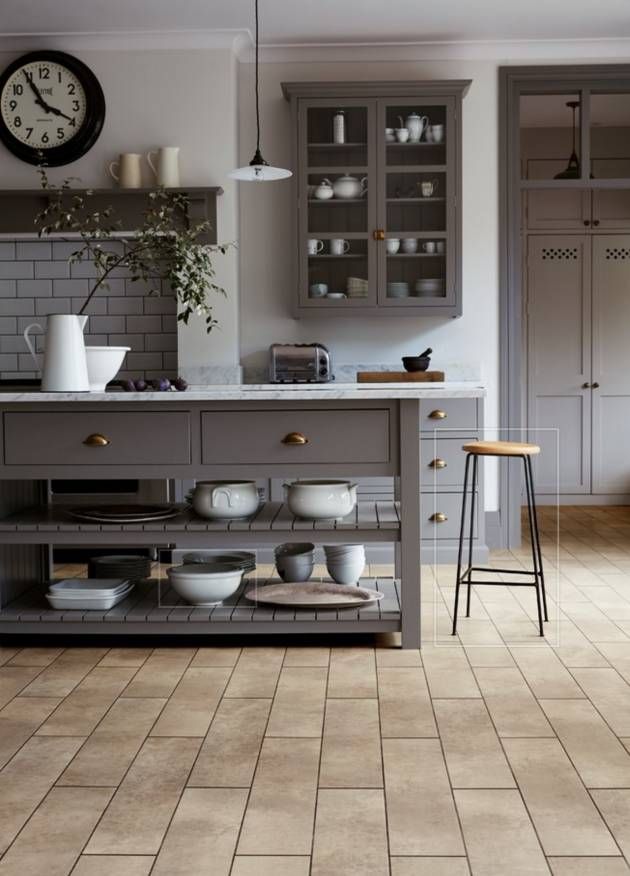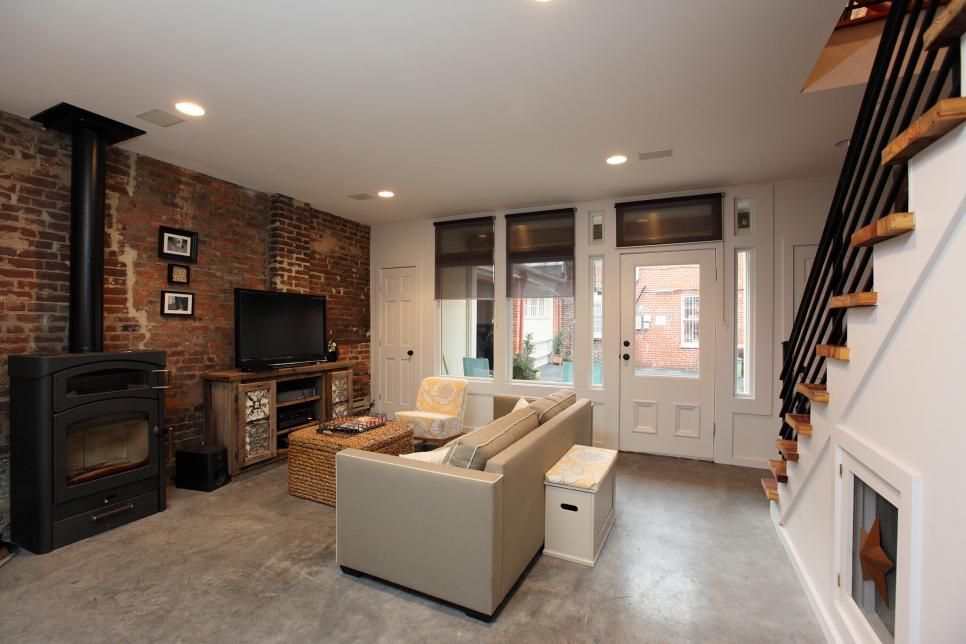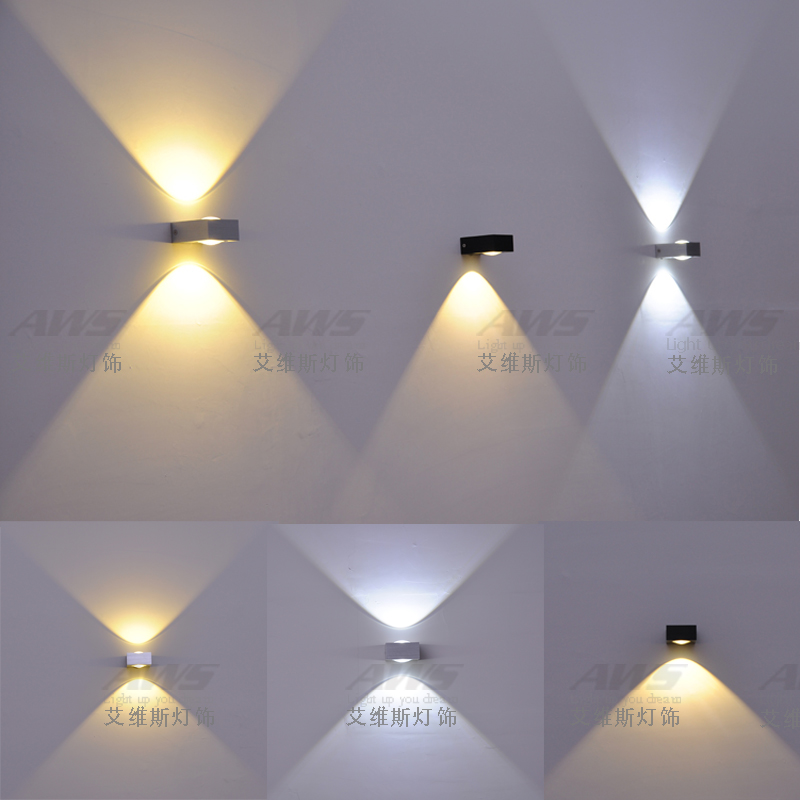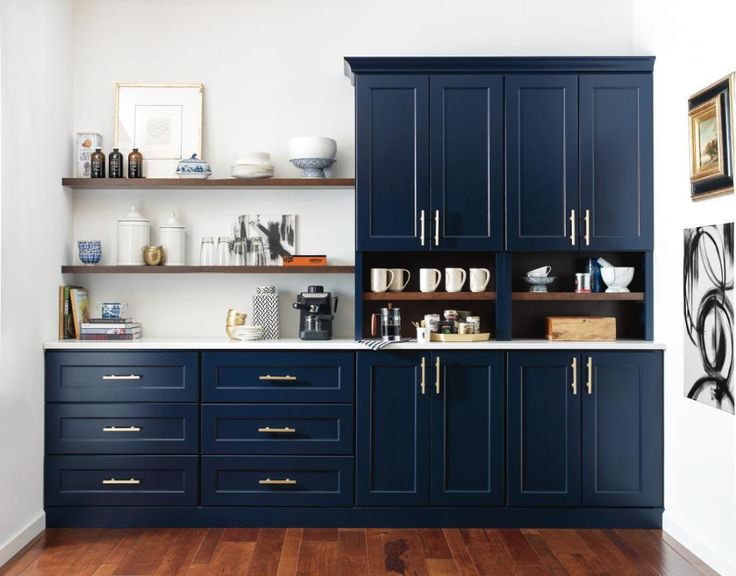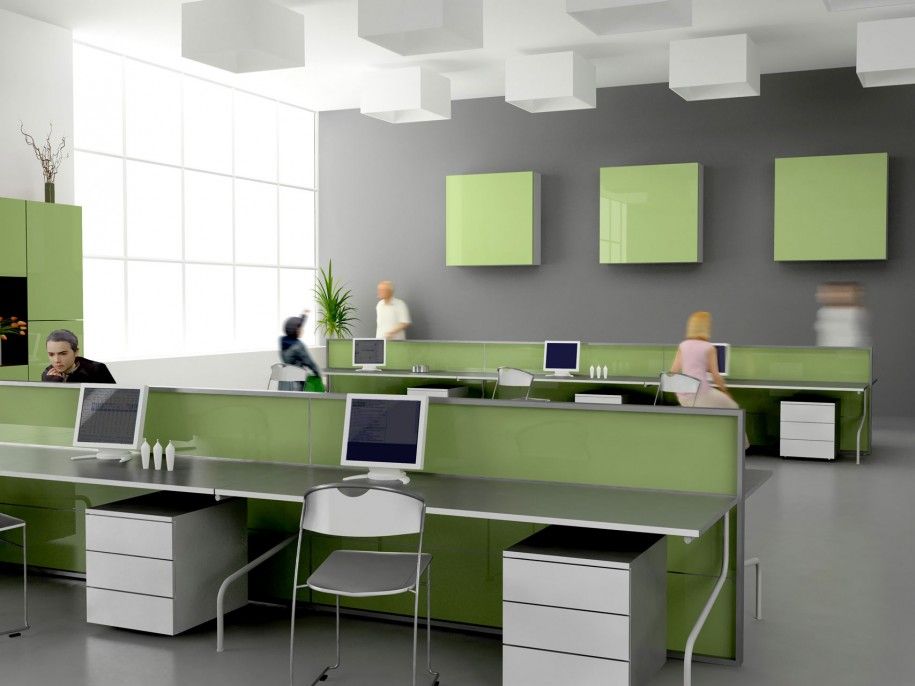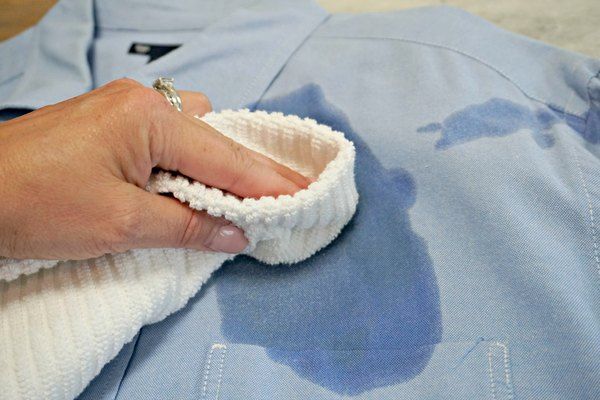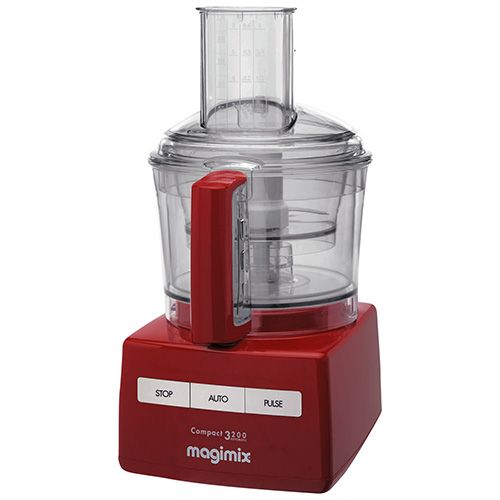Ceramic floors for kitchens
Pros & Cons of Ceramic Kitchen Tile
If you’re thinking about installing a new kitchen floor, tile might be the first option that comes to mind. Ceramic tile is a classic choice for the kitchen. It not only looks elegant and clean, but it’s also very easy to maintain and durable. The versatility offered by tiles almost guarantees that you’ll find a style that suits your kitchen floor ideas.
Silk Tile in Light Gray Matte available at Avalon Flooring
Pros of Ceramic Kitchen Floors
Durability
Ceramic tiles stand up well to the wear and tear you’ll find in almost every kitchen, from muddy footprints to spills and splashes. Ceramic is also super easy to clean. Dry-dusting with a broom or vacuum will do the trick most days, followed by a damp mop with hot water and a mild cleaning solution.
Affordable
The huge variety of low-priced options makes ceramic tile one of the most affordable kitchen flooring choices. You’re sure to find a ceramic tile design that fits your budget.
Style
Have you seen the trending styles of ceramic tile? Wide tile is trending for kitchens with good reason—it makes your kitchen look even bigger! Ceramic tile is available in a wide variety of colors to match any decorating scheme. Plus, modern printing technology can generate ceramic tile surfaces which mimic natural stone (marble and travertine), concrete and wood, and clean monotone styles.
Twenties Classic Patterned Tile available at Avalon Flooring
If style and durability are your top criteria, then ceramic tile is the way to go.
Cons of Ceramic Tile in the Kitchen
While ceramic tile can be an excellent choice for your kitchen floor, it does come with a few drawbacks.
Usability
Ceramic tile can crack as floors settle, and a dish or glass dropped on it is virtually guaranteed to shatter. It can also be cold and hard underfoot, so use a rug or cushioned mat to cancel out the discomfort.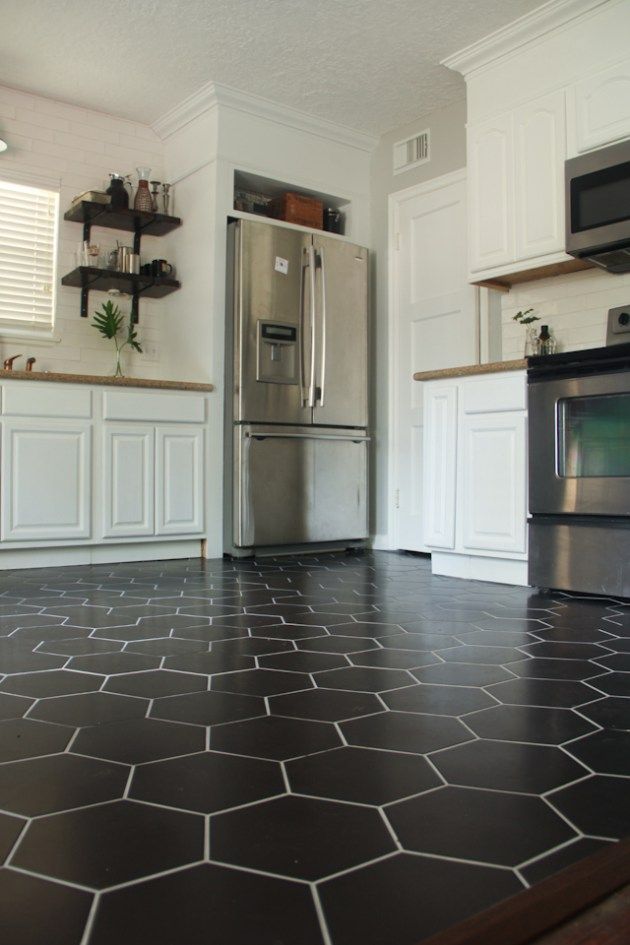 Moisture makes ceramic tile slippery; a textured surface can provide slightly more traction.
Moisture makes ceramic tile slippery; a textured surface can provide slightly more traction.
Ceramic tile can also be sensitive to extreme temperatures. While this may not make ceramic the best choice for outdoor tile setups or a non-climate-controlled space, the kitchen is usually a safe bet.
Maintenance
A floor with ceramic tile inevitably means there will be grout holding that tile together. Tile grout needs to be sealed periodically, and it often requires specialty cleaning in order to prevent stains from forming between tiles.
Now that you have all the information, it’s time to decide if ceramic tile is right for your kitchen floor. Still need help making the choice? Stop by one of our showrooms for advice and to see our available ceramic tile options!
Questions?
Questions?
Compare Products
15 Different Types of Kitchen Floor Tiles (Extensive Buying Guide)
2. 2K shares
2K shares
Related: Reclaimed Tile and Terracotta Flooring | Staircases with Tile Flooring | Living Rooms with Tile Flooring | Bedrooms with Tile Flooring | Bathroom Floor Tiles
Kitchen Floor Tiles Buying Guide
When it comes to buying kitchen flooring, your options are massive. It’s not unusual to feel overwhelmed by the sheer amount of choice available. In other rooms in your home, you often have just one option, say, wood or one-run carpet. However, you have factors other than aesthetics to consider when it comes to your kitchen.
Not only should the flooring in your kitchen look great, but it must also stand up to the rigors of everyday use as well as the ever-present threat of humidity, moisture, and water. Then, you have to choose colour, texture, etc. because the floor and the wall colors are responsible for tying the room together. Without guidance you could end up with a kitchen that feels fragmented.
Start your search by narrowing your choice down to flooring type. Though tile isn’t your only option, it’s certainly one of the best (not to mention, most popular).
Below we guide you through the top options for kitchen tile flooring materials as well as additional design options like dimensions, color and texture, tile rating, porosity, and much more.
Things to consider when buying Kitchen Floor Tiles
Most people choose tiles because they’re easy to keep clean, especially in a kitchen, where cleanliness is so important. You’ll want to choose a tile that won’t stain easily so be sure to know the cleaning requirements before you make your final choice of floor tile.
Fun Fact: A white tile in a country house with a couple of dogs and a parcel of kids is going to drive you to distraction in no time.
Bring a sample of your cabinetry with you when you go to the tile store. Ensuring a cohesive design between cabinets and floor is crucial to the overall design of the kitchen.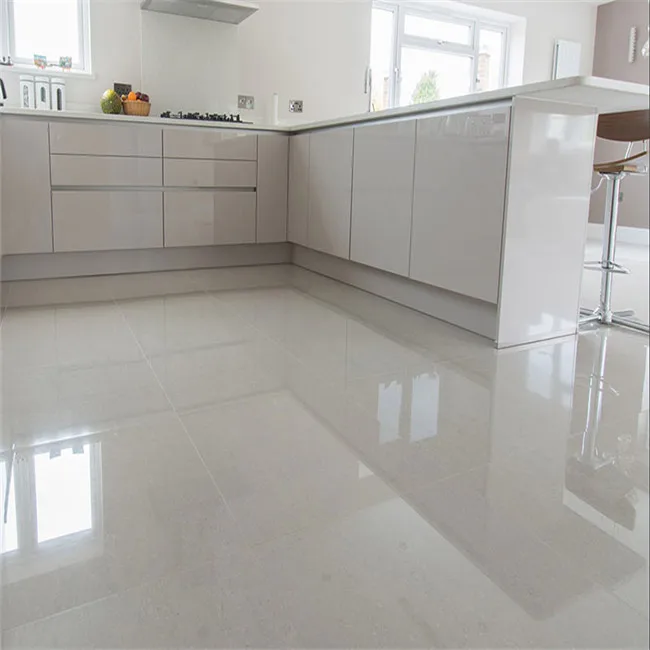
If at all possible you want your kitchen floor tiles to be indestructible, or as close as. Laying tiles is a job you only want to do once or twice in your forever home so make sure you buy what’s suitable for your family. Each type of tile has differing qualities and sometimes you may lose strength for beauty.
Important: If you’re building a new house or remodeling an old one, order your tiles as soon as you’ve decided on your floorplan and cabinetry. There’s no point booking the tiler and then ordering your tiles – they may need to sourced from a provider.
A. Kitchen Floor Tile Materials
Once you’ve settled on tiles as your kitchen floor type, it’s time to take a closer look at the specific material options available.
The problem is there are dozens upon dozens of kitchen floor tile materials on the market. To make your decision a little easier, we’ve narrowed down the options to the fifteen best types of kitchen flooring tiles.
To make your decision a little easier, we’ve narrowed down the options to the fifteen best types of kitchen flooring tiles.
Here are the most popular kitchen flooring tile materials.
1. Ceramic Tile Kitchen Flooring
Source: Pinterest
Ceramic tile is one of the most commonly used kitchen flooring materials.
The main reason for its popularity is its water and stain resistance. Use “glazed” ceramic tiles for even more humidity resistance.
Ceramic tiles are also extremely durable. In the kitchen, where accidents are common, a dropped pot, plate, or other object likely won’t cause any damage to your ceramic flooring. And if, for some unforeseen reason, your ceramic tile flooring is damaged, replacing the damaged tiles (instead of the entire floor) is a relatively painless procedure.
In addition to its functionality, ceramic tile is also notable for its good looks, with multiple design options available so you can create a unique kitchen floor.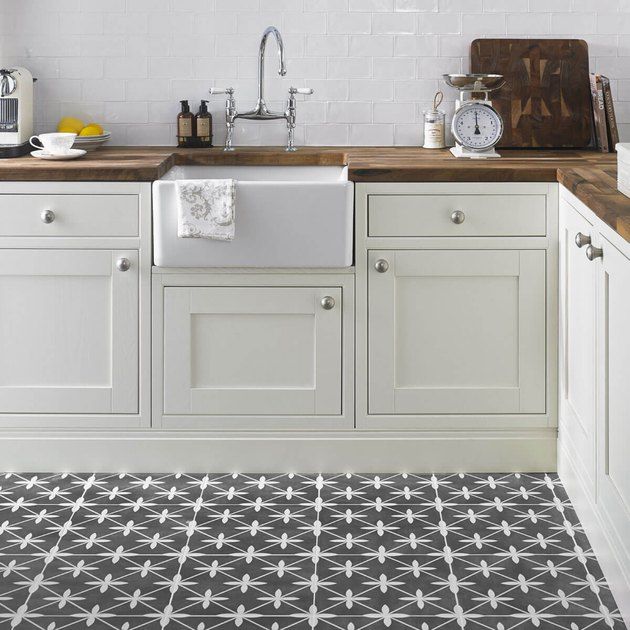
The only downside to ceramic tile is its hardness and weight. It’s not a very comfortable flooring material to stand on for long periods. It’s also so heavy that it’s not always a smart option for upper-story kitchens.
Ceramic tile is a mid-range flooring material as far as price goes.
2. Porcelain Tile Kitchen Flooring
Porcelain tile is very similar to ceramic tile yet takes durability and water resistance up another few notches.
Simply put, porcelain tile flooring is one of the most durable kitchen floor materials. It’s so strong that it can even be used in commercial kitchens and other high-stress environments.
Not only can porcelain tile stand up to heavy impacts, but it’s also even more water-resistant than ceramic. The Porcelain Tile Certification Agency requires porcelain tiles to have less than a 0.5% water absorption rate.
Porcelain tile flooring is also low maintenance. Cleaning it usually only requires sweeping and perhaps mopping with a damp rag.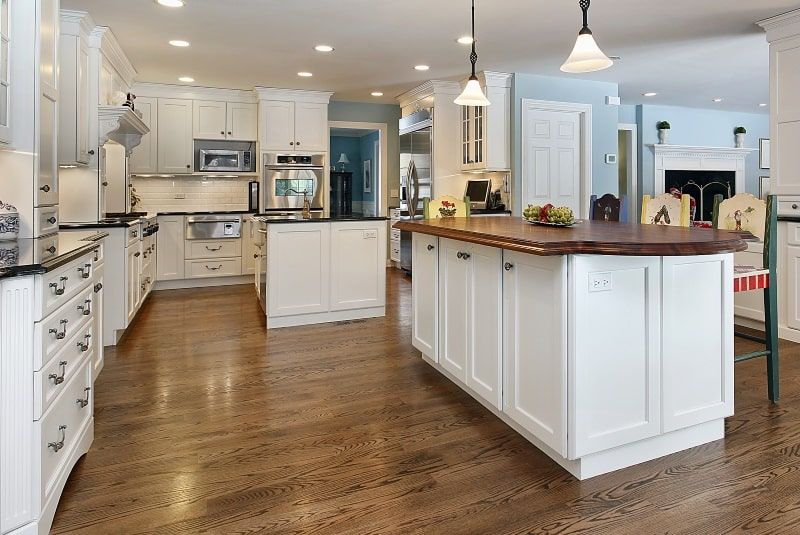
Take good care of your porcelain tile kitchen floor, and you can easily expect it to last for several decades.
Like ceramic tiles, the main downside to porcelain tiles is weight. They are often too heavy for upstairs use. DIY installation is also tricky because of the weight.
Porcelain tiles are more expensive than ceramic tiles. The problematic installation also means there are higher installation costs.
3. Travertine Tile Kitchen Flooring
Source: Houzz
Travertine tile is a flooring material that’s becoming increasingly popular in kitchens.
A type of limestone, travertine has a natural charm that undoubtedly adds to its popularity in kitchens where a subdued, rustic look is desired. It’s most commonly available in earth tones like brown, rust, and tan.
Interestingly, travertine is also considered a high-end luxury material. The unique patterns found within every tile make each one unique.
Though travertine tile flooring does need regular maintenance and care, it has the potential to last for decades on end.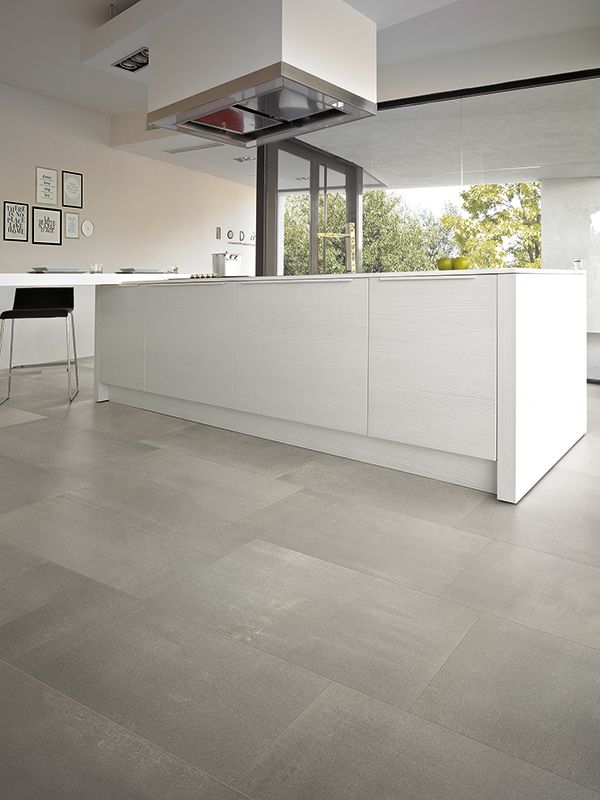 Spend the required time caring for it, and it will likely last you a lifetime.
Spend the required time caring for it, and it will likely last you a lifetime.
Another benefit of the travertine tile is its eco-friendliness. It’s completely recyclable, 100% biodegradable, and used in its natural form.
The big downside to travertine flooring is the above-stated required maintenance. Primarily when used in a kitchen where moisture is abundant, a penetrating sealer and barrier surface sealer must be installed on regularly.
Travertine tile is a mid-range flooring material as far as price goes, falling somewhere between ceramic and porcelain depending upon the particular variety.
4. Slate Tile Kitchen Flooring
Natural slate tiles are loved by many for their gorgeous natural beauty.
Use this flooring material in your kitchen for a contemporary look that still reminds you of the wonders of the natural world.
Slate flooring is such an appealing kitchen flooring material because each slate tile looks different. A fully-tiled slate floor doesn’t look like any other in the world.
In addition to looks and style, slate tile scores high in the functionality department. It’s strong and durable, standing up well to cracks, scratches, chips, and more.
Though slate tiles are resistant to staining and water damage, sealing regularly is required to give them the longest lifespan possible.
Use slate tile for your kitchen, and your home resell value goes up. Because it’s considered a high-end luxury kitchen flooring material, it can add to the overall value of your home.
The biggest negative to this flooring material is undoubtedly its high price. Slate tile is costly, especially when you buy top-grade slate (which you should when tiling a kitchen).
Like most other natural stone tiles, installing a slate tile floor is a demanding process. It’s usually best to leave the installation up to the pros.
5. Marble Tile Kitchen Flooring
Source: Houzz
If an elegant, modern kitchen is what you’re after, few flooring materials do the job as well as marble.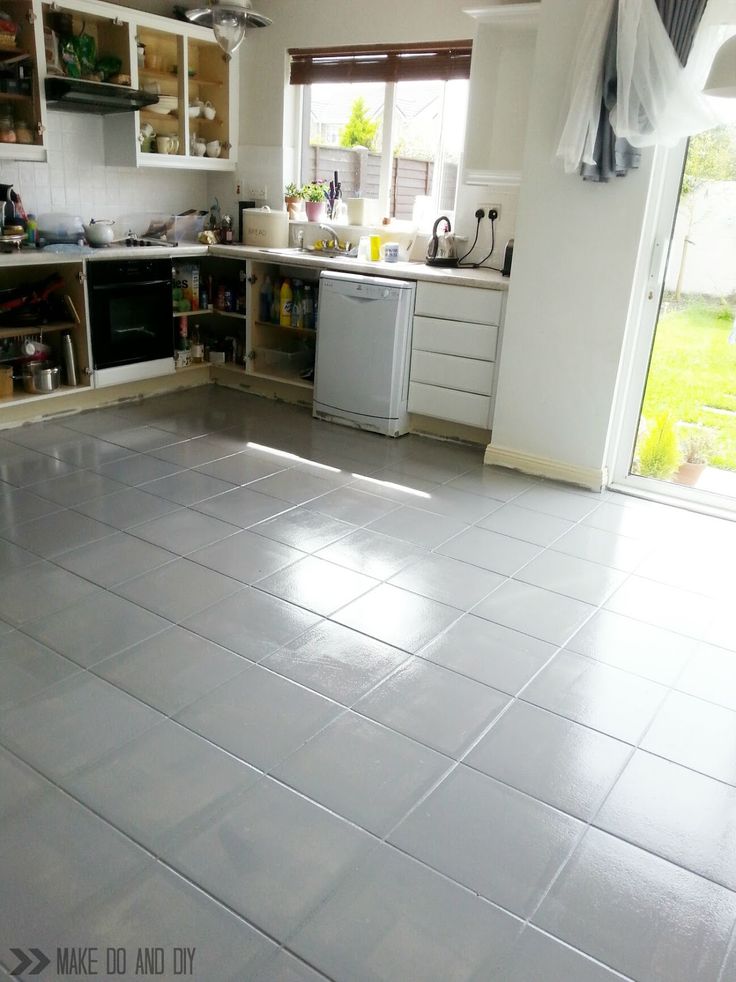
Marble tile is quite breathtakingly beautiful. It’s long been a staple of high-end, ultra-luxurious kitchens where chic style is just as crucial as overall functionality.
Highlights of marble tile flooring in the kitchen include the wide variety of colors it’s available in as well as its highly polished appearance that allows individual colors to shine even more brightly and dramatically.
Unfortunately, for such highly-valued flooring material, marble tile has its fair share of drawbacks, especially when used in the kitchen.
While it is waterproof, it gets very slippery when wet. Some types of polished marble are even slippery when completely dry.
Marble tile is also highly susceptible to scratching and staining. Periodic resealing is required to ensure a minimal amount of wear and tear.
Finally, marble is one of the most expensive kitchen flooring materials.
In addition to the cost of the raw material, installing marble is expensive, especially if you want a mosaic or other complex design.
6. Granite Tile Kitchen Flooring
Like marble, granite has a solid reputation as a luxury flooring material.
Install a granite tile floor in your kitchen for an upscale look. Complete the sophisticated design by adding in a matching granite countertop.
Granite tile flooring is available in a wide variety of colors. The material usually has a natural, mottled pattern. Add granite polish to brighten the colors contained in each tile.
Durability is another benefit of granite tile kitchen flooring. It’s one of the hardest natural stone materials regularly used for flooring.
Granite is stain resistant and even holds up well to heavy impacts. It’s a good choice for high-traffic kitchens that get a lot of regular wear and tear.
One downside to granite tile is its slipperiness, especially when polished. Be very careful when using granite as flooring in kitchens. In fact, homes with children or the elderly should avoid it altogether.
Granite tile is slightly more expensive than other mid-range kitchen flooring materials.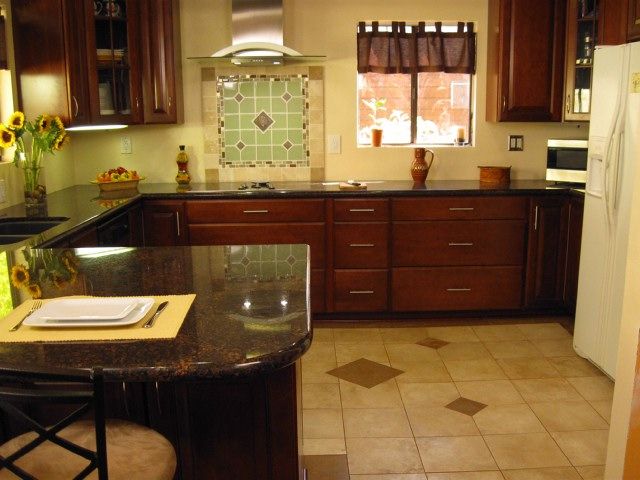
7. Onyx Tile Kitchen Flooring
Source: Surface Art
Onyx is yet another type of natural stone that looks great when used as kitchen floor tile.
Though it’s also considered a luxury flooring material, it’s much more rare than either granite or marble. Use it in your kitchen for a uniquely exotic look.
Despite the sheer beauty of onyx tile flooring, it’s not always the best choice for your kitchen floor. The material is quite soft and scratches and scrapes quite easily with regular use.
Of course, proper maintenance helps extend the lifespan of onyx flooring but it requires a lot of dirty work. In addition to regular resealing, onyx requires even more regular cleaning, using a special cleaner to prevent damage.
Finally, onyx tile flooring is expensive. The material is up there with marble and granite regarding price.
8. Quartzite Tile Kitchen Flooring
Quartz tile flooring, also known as quartzite, has long been a widely-admired option for kitchen floors.
The attractive flooring material is known for its shiny, opulent look. The elegant charm makes quartzite a popular option in modern kitchens.
Quartz tile flooring is notable for its non-porous structure. Very little water seeps in, adding to the material’s lifespan. The non-porousness also keeps bacteria out, making quartzite a hygienic kitchen flooring option.
Another benefit of quartz tile for your kitchen floor is its strength. The natural stone material holds up well to scratches and heavy impacts. Chipping or cracking is uncommon.
Finally, quartz tile is cost-effective compared to other types of natural stone tiles. It gives off a luxurious appearance without a significant investment upfront.
Like other smooth, shiny types of kitchen floor tiles, quartz gets slippery when wet. You must clean up spills quickly if you install quartzite on your kitchen floor.
9. Sandstone Tile Kitchen Flooring
Source: Pinterest
Not many people use sandstone tile for their kitchen floors. But that doesn’t mean it’s not a good option to consider.
But that doesn’t mean it’s not a good option to consider.
Sandstone tile flooring is notable for its natural looks. It’s a classy, stylish material that doesn’t look overwhelmingly luxurious. It’s a good mix of rustic and modern regarding design.
Most sandstone tile is the same color as natural sandstone: mostly gold, red, or brown, and the tiles often contain a beautiful mixture of these colors.
Another interesting design element of sandstone tiles is their texture. Unlike most natural stone tiles that are polished smooth, sandstone is often left naturally rugged.
Of course, it’s smoothed out enough so that it doesn’t hurt your feet, but it’s still left with enough texture to prevent slipping accidents.
Aside from its natural beauty, sandstone is a great flooring material because it’s rock-hard. It’s ultra-durable and doesn’t easily scratch, stain, crack, or chip.
Finally, sandstone tile is an eco-friendly kitchen flooring choice. Buy from a reputable manufacturer for a product that’s all-natural, recyclable, and biodegradable.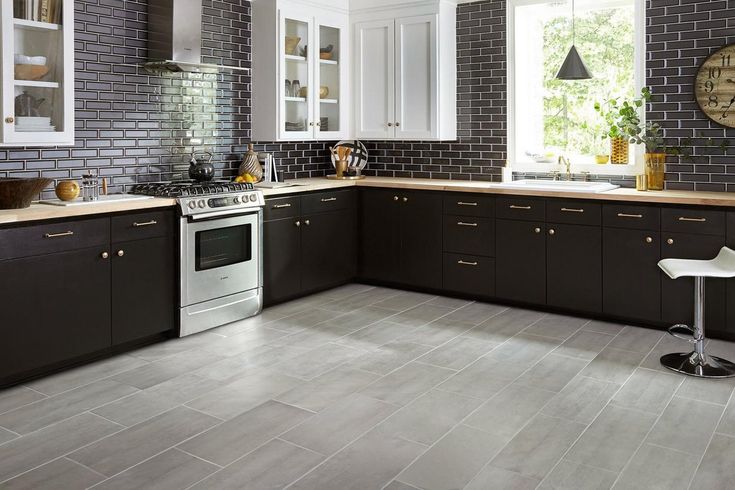
Chief among the few downsides of sandstone tile is its porousness. The material absorbs much more water than other natural stones.
The absorption rate for sandstone is usually between 1% and 6%. It’s imperative to select the tile with the lowest absorption rate possible if you want to use sandstone in your kitchen. Tiles with a high water absorption rate may warp and be vulnerable to damage from liquid or mold. You also need to be aware that sandstone ages so how it looks when it’s freshly laid is not how it’s going to look in 5-10 years time.
Sandstone tile flooring is a mid-range choice for kitchen flooring when it comes to price.
10. Cement Tile Kitchen Flooring
Source: Cote de Texas
Cement tile is a relatively uncommon kitchen flooring material that can look great in the right kitchen.
The material looks beautiful in a stark, minimalist way. A variety of design and color options give you a lot of flexibility in how the finished product turns out.
Cement tile flooring is often a mixture of modern and industrial in style, (don’t think poured concrete). With a little research, you can easily find cement tiles that will work well in a traditional-style kitchen.
Like all materials, cement tile has a few negatives. Chief among these is that it’s porous, prone to scratching, and easily stained. It also has inconsistent sizing and therefore more expensive to install.
Proper care and maintenance are key if you opt to use cement tile for your kitchen floor. You must have the floor resealed on regularly to extend its lifespan but even regular sealing won’t stop it from staining if you don’t clean the spill immediately.
Hiring a contractor to install your cement tile floor also improves its lifespan. Since the material isn’t the most durable around, it requires a professional touch when it’s put in.
Cement tile isn’t expensive, but it isn’t cheap either. It’s a mid-range priced kitchen flooring material.
11.
 Pebble Tile Kitchen Flooring
Pebble Tile Kitchen FlooringSource: Pinterest
If you want a hip, high-end look for your kitchen, consider pebble tile bathroom flooring.
Currently one of the trendiest options available, the highlight of this floor tile type is undoubtedly its contemporary style. The popularity of pebble tile as a kitchen flooring option will probably be determined by its reliance on maintenance for a good look.
Pebble tiles are made up of small pebbles, of various colors and sizes, held together by resin or concrete. Because the pebbles are mined naturally from stone, no two pebble stone flooring tiles look the same.
Like sandstone tile, pebble tile flooring isn’t usually smooth. Instead, the individual pebbles create a textured finish. Find the right in-between for the perfect amount of slip resistance.
Pebble tile flooring requires a lot of grout to remain sealed and held together. Preventing discoloration of this grout requires a lot of maintenance.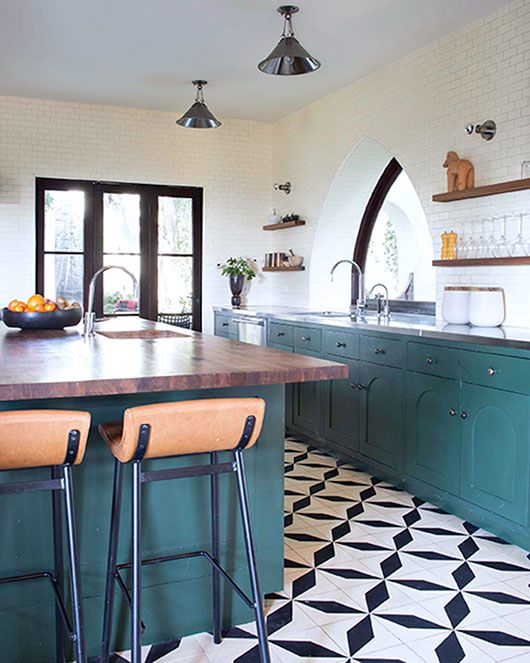
Pebble tile flooring is a little over the mid-range price point for types of kitchen floor tiles.
12. Glass Tile Kitchen Flooring
Not everyone likes the appearance of natural stone flooring tiles. Those that prefer something different should consider glass tile flooring.
Add a dash of color and brightness to your kitchen with glass tile flooring. Available in a wide variety of colors and finishes, you can install this flooring material in a wide range of patterns and designs.
Glass tile flooring can be laid to create an atmosphere ranging from sleek and stylish to laidback and traditional.
Other than looks, glass tile is notable for its cleanliness. It’s one of the most hygienic flooring materials available.
In addition to preventing bacteria, stains, mold, and mildew, glass tile also shows dirt. It looks dirty when it’s dirty, so you know when it’s time to clean.
Perhaps the biggest drawback to glass tile flooring is that it’s susceptible to scratches.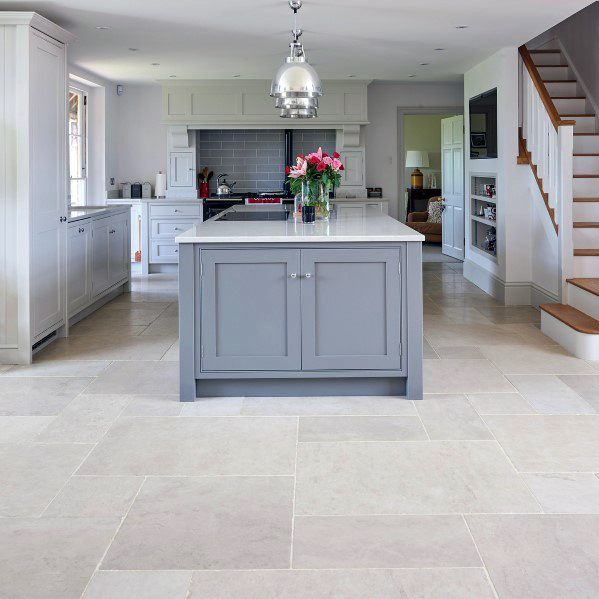 You’ll undoubtedly see scratches accumulate over time if the material is used in a high-traffic area like your kitchen.
You’ll undoubtedly see scratches accumulate over time if the material is used in a high-traffic area like your kitchen.
Fortunately, replacing scratched tiles is easy. Only the tiles that are scratched need to be replaced – not the entire floor.
Glass tile flooring is also fairly expensive, both the material itself and the installation process.
13. Floating Wood Tile Kitchen Flooring
Floating floors are a unique style of flooring that is quickly catching on in all areas of the house, including the kitchen.
While floating floors can be made with several different materials, with one of the most popular being engineered wood.
Engineered wood floating floors are available in numerous varieties, including planks, boards, and tiles.
According to Armstrong Flooring, floating floor wood tiles are connected to each other rather than to the sub-floor, enabling you to install a new kitchen floor without tearing out your old kitchen floor.
An interesting benefit of a floating wood tile kitchen floor is that it expands and contracts with differing humidity levels.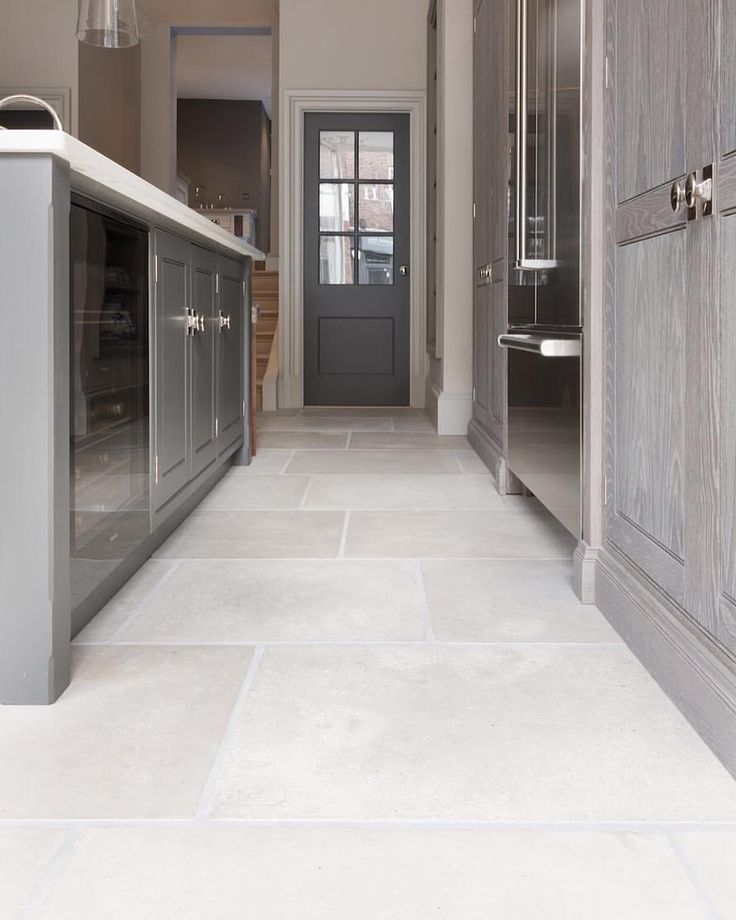 Moisture doesn’t damage this flooring type the way it damages others.
Moisture doesn’t damage this flooring type the way it damages others.
A floating wood tile floor is also relatively easy to install. Most people can take on installation as a DIY project rather than hiring a pro.
The big con to floating floors is they’re more susceptible to damage than normal floors. They have more give and flexibility than normal floors, often causing them to wear out more quickly.
Engineered wood floating tiles are relatively affordable. What makes them an even more cost-efficient choice is the fact that they can usually be installed without a professional’s help.
14. Cork Tile Kitchen Flooring
There’s no denying that cork tile flooring is a beautiful choice in kitchens.
It has a unique look that you simply don’t see very often. In addition to looks, cork has a very nice feeling underfoot. It’s soft on the feet, making it a perfect choice for children, the elderly, and those that value comfort.
Cork tiles can be installed over wooden floors or dry concrete or even old floors if they’ve been carefully prepared—any lumps or bumps will show through the cork tile.
Another benefit of cork tile flooring is its insulation properties. It can keep your kitchen cooler in the summer and warmer in the winter.
Unfortunately, cork isn’t the most durable flooring material. When used in the kitchen, it’s vulnerable to scratching, denting, and water damage.
Ensuring a proper seal is vital to preserving your cork flooring. Yet even with a top-quality seal, water damage is possible in the event of a flood.
Pricewise, cork tile flooring is a mid-range choice for kitchen floor tiles.
15. Rubber Tile Kitchen Flooring
Rubber tile flooring is catching on big time in areas where water is prevalent, including kitchens and bathrooms.
In addition to some of the best water resistance of any flooring type, rubber tile flooring looks unique. It’s available in lots of fun colors so you can tailor your kitchen style to your individual preferences. Its comfortable surface makes it a perfect choice for a kitchen area where you can spend a lot of time standing.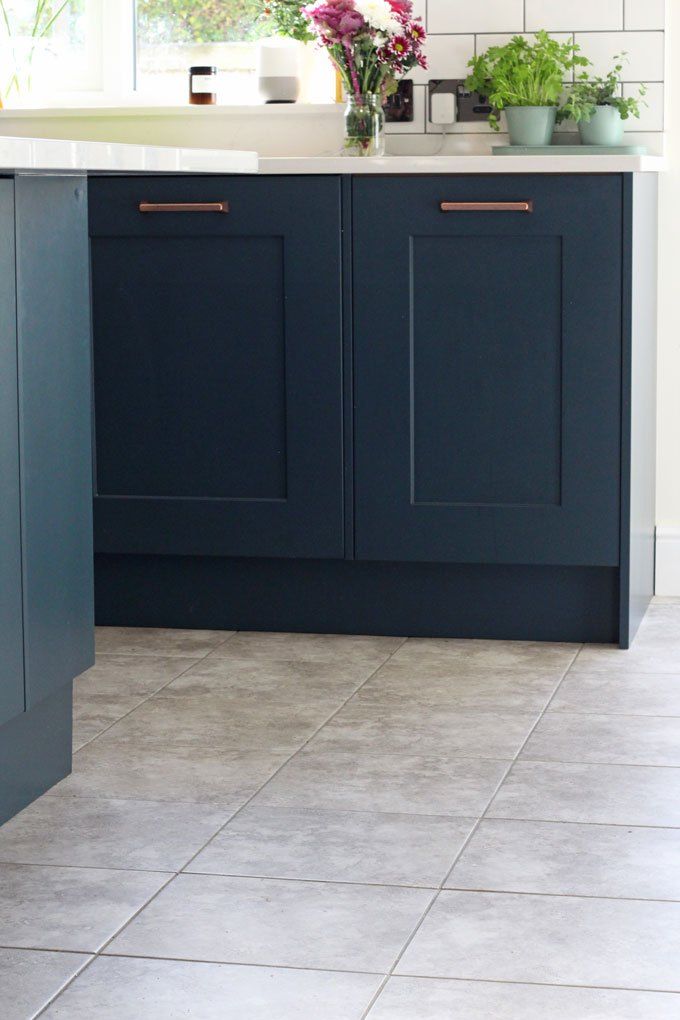
Rubber tile flooring is also durable and low maintenance. It doesn’t take much care to keep it in tip-top shape for years to come.
And if your rubber tiles are damaged, single tiles can be easily replaced. You don’t have to replace the entire floor at once.
The biggest drawback to rubber tile kitchen flooring is the expense. It’s one of the most expensive flooring materials for quality tiles.
B. Kitchen Floor Tile Design Options
After you select a kitchen floor tile material type, there are a few additional design options to consider.
These include tile dimensions, rating, porosity, color, finish, and texture.
1. Kitchen Floor Tile Dimensions
The dimensions of your kitchen floor tile dictate both its looks and functionality.
Tile thickness is the first choice to make. Most flooring tiles are between ½ inch and 1 inch thick.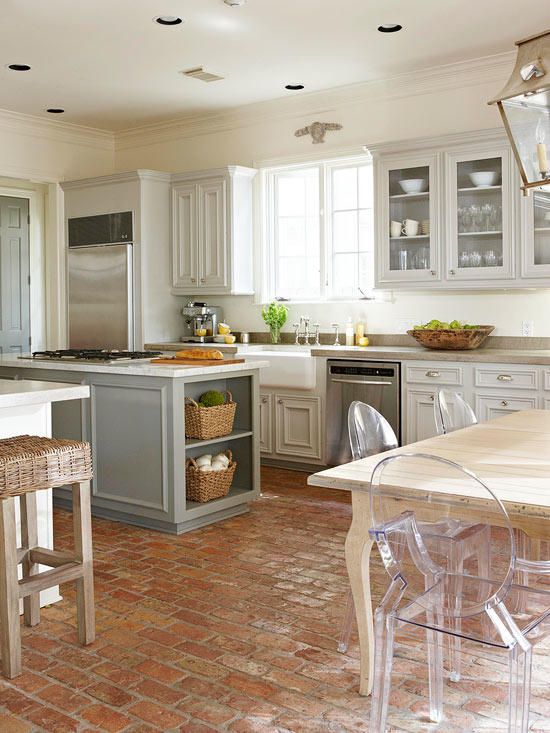
As for length and width, flooring tile bought directly from a manufacturer is usually somewhere between 3×3 inches and 24×24 inches.
Custom flooring tile can be bought in just about any dimensions imaginable. Additional options include non-square shapes like rectangles, octagons, and hexagons.
2. Kitchen Floor Tile Ratings
Source: The Spruce
According to Lowes, tile rating relates to the hardness of the material you’re using.
Different rooms require different tile ratings. Your kitchen should utilize tiles rated for moisture resistance and slip resistance.
Your kitchen tiles should also be designed for heavy use.
3. Kitchen Floor Tile Porosity
Source: Lowes
Porosity is an important measurement to consider in your flooring tiles.
It relates to the amount of water the tiles absorb. For a kitchen where water is abundant, you want a low-porosity tile that absorbs minimal water.
4.
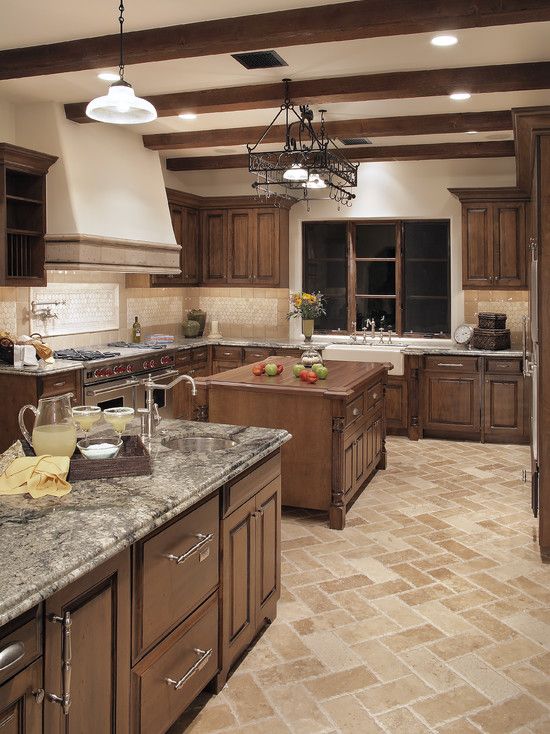 Kitchen Floor Tile Color, Finish, and Texture
Kitchen Floor Tile Color, Finish, and TextureNow comes the fun part – selecting the specific color, finish, and texture of your kitchen floor tiles.
Of course, the specific material you choose largely dictates your options. Many materials have a variety of colors and finishes available you can choose from to match the overall style of your kitchen.
Choosing a textured tile is smart for a kitchen to improve slip resistance when wet.
C. DIY or Professional Installation?
The difficulty of installing kitchen floor tiles relies largely on the type of material you’re using.
Certain materials almost always require professional installation. Materials like granite and marble are two examples.
Materials that require complex installation also require the help of a professional. Due to their small size, glass tiles are difficult for most people to install on their own.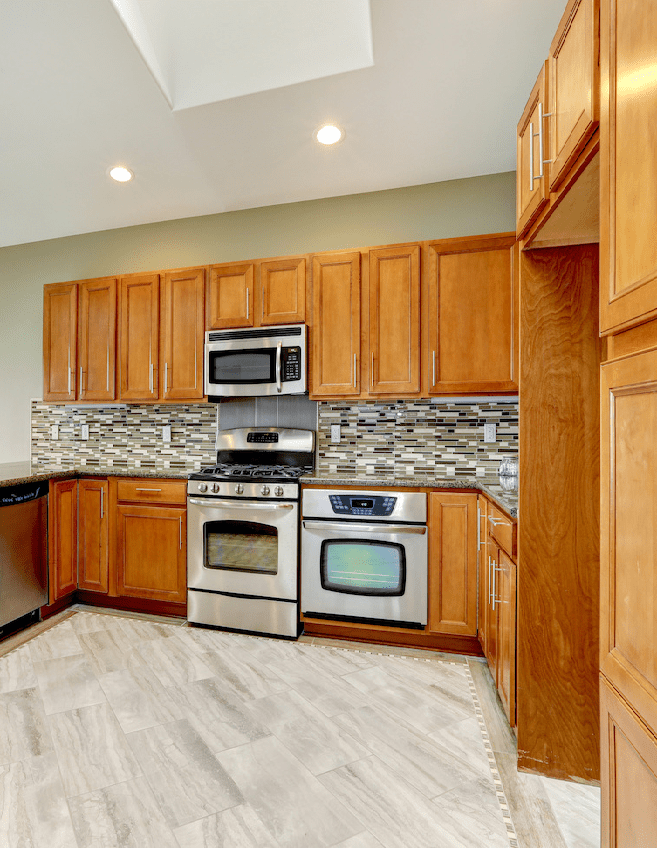
Other materials, however, can easily be installed by your average Joe. Rubber tiles are the most obvious example.
II. More Details
Here are some more important factors to consider when buying kitchen floor tiles.
A. Cost and Budget
Pricing for kitchen floor tiles varies wildly depending on the type of material and installation method you choose.
Set your budget ahead of time and stay within it. If you’re tight on money, consider a low-cost material like ceramic tiles.
Really tight on money? Consider forgoing tiles altogether.
Laminate and vinyl flooring look great, are usually water-resistant, and are much cheaper than almost any kitchen floor tile available.
According to HomeAdvisor, the average kitchen floor costs $2,866. They go on to give the lower end of the price range like $200 and the upper end as $10,000.
The organization lists the average cost of installing a ceramic or porcelain tile kitchen floor as $1,588.
They list the average cost of installing a natural stone tile kitchen floor as slightly more at $1,830.
III. Where to Buy Kitchen Floor Tiles Online
Now that you have a better understanding of the different types of kitchen floor tiles available, here’s our recommendation of the best online merchants to buy them from:
- Wayfair
- Lowes
- Overstock
- TilesDirect
Related: Types of Tile Removal Tools | Types of Tiling Tools
2.2K shares
Kitchen Floor Tiles for Beautiful Design + 150 PHOTO
Kitchen Floor Tiles, of course, should be practical and durable, but not necessarily boring. Because the kitchen is often combined with the dining area in an open-plan space, a kitchen floor can be a great way to bring the different areas of a room together, creating a cohesive finish.
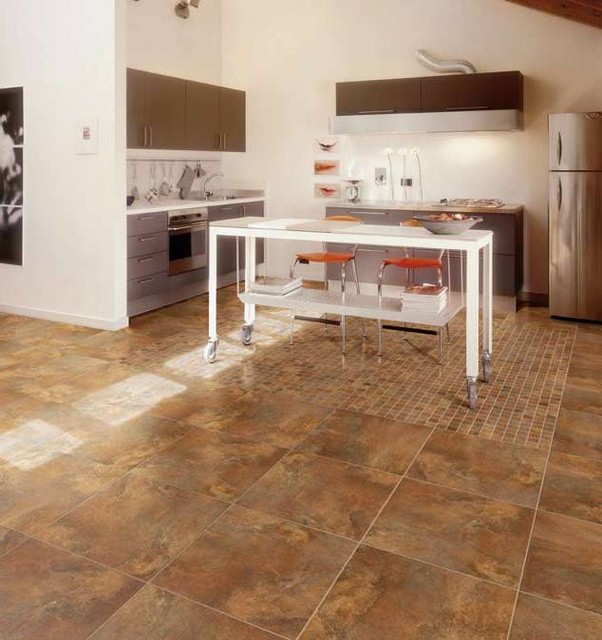
Content:
Content:
- Advantages of ceramic flooring
- Concept of kitchen flooring
- How to create the ideal floor
- Before you start
- do it yourself
- Easy work
- Top-6 Top-6 of the lead trends
- GALLERY: The best floor tile design options for the kitchen
Advantages of ceramic flooring
1Modern ceramic tiles are generally the most reliable choice for kitchen flooring because they are waterproof, resistant to stains, scratches, and are also easy to clean;
2 good ceramics or porcelain stoneware will last a lifetime if properly installed and treated;
3if you are thinking about installing underfloor heating, ceramic tiles are generally excellent for underfloor heating, the most preferred material for this purpose.
Ceramic tiles excellent for underfloor heating
Floors must be clean, dry, structurally sound and level.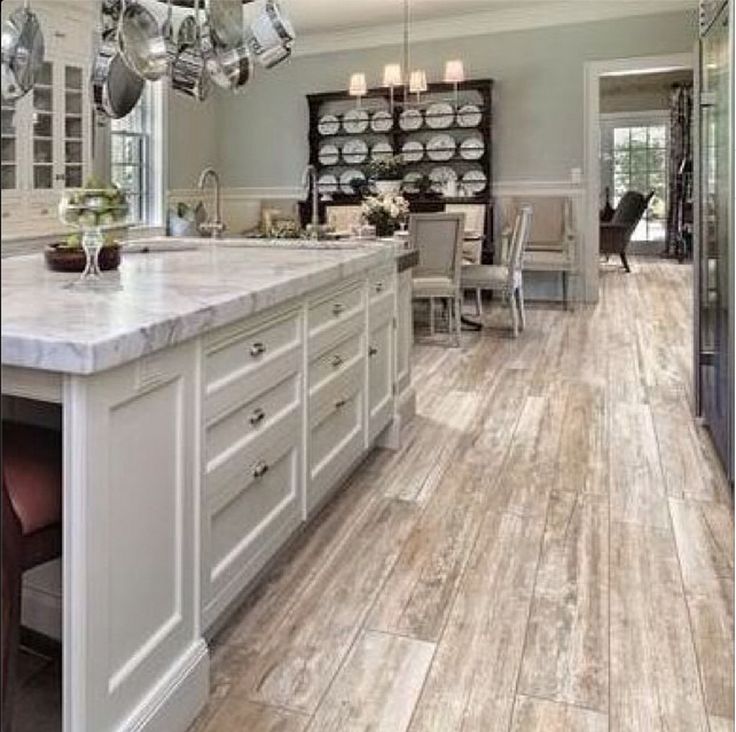 Most suppliers recommend using an installer who is experienced in laying this type of flooring.
Most suppliers recommend using an installer who is experienced in laying this type of flooring.
If you are dealing with larger slabs, as well as a non-standard format, or with a large layout type pattern, then they usually take more time to install, effort, and are much more expensive.
Stone floor tiles in brown tones blend in well with wooden interiors
Don't know what to do? Check out our tips below.
Read also: Modern kitchen interior design ideas in a private house + 130 PHOTOS and TOP-8 trends in 2019Kitchen flooring concepts gamma for the floor.
Patterned floor tiles add charm and style to your kitchen floor.
Natural motifs such as stone or wood are always popular. They give a natural authenticity.
Gray complements the main color scheme chosen
The current trend is "mimic" ceramics, which recreate the look of natural materials while offering an easy maintenance finish that no truly natural material can offer, even though it is many times more aesthetically pleasing .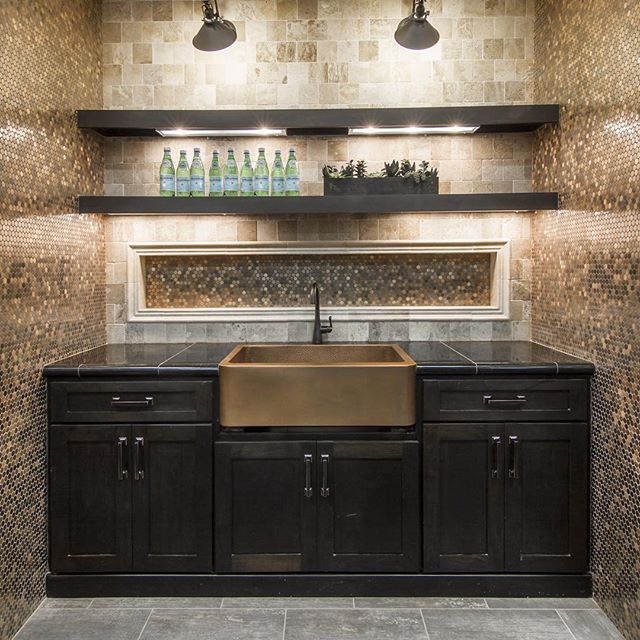
Porcelain tile fits all kitchen styles
Classic porcelain tile fits all kitchen styles. It fits perfectly into frequently used rooms that are subject to maximum wear and tear.
Dark color with white looks beautiful and elegant
Durable, hard-wearing, stain-resistant, easy to clean, granite is an ideal material for family homes.
Achieve the effect of terracotta or clay earth with practical lightweight ceramic tiles.
Ceramic tiles
An ideal addition to the countryside, it needs minimal attention. Fill the space with bright shelves, cream blocks and open shelving.
Stoneware is a good addition to any kitchen and can be used to achieve the effect of limestone slabs.
A great addition to any kitchen
This modern country style home will have a light feel combined with classic white blocks that pairs well with a variety of furnishings. Be adventurous with your kitchen floor.
The kitchen is one of those rooms in the house that can have several different types of tiles, in different forms, all of which enhance the kitchen beautifully.
An example of different views in a room
The kitchen is one of those rooms in the house that can have several different types of tiles, in different ways, all of which enhance the kitchen beautifully.
The floor must be safe to walk on
When choosing a kitchen floor for your home, think about the main points. The flooring needs to be safe to walk on and, for example, glossy kitchen floor tiles can be unsafe to walk on.
White classic kitchen
Decipher the difference between species that may not only be ceramic. The word "tile" refers to a flexible material that can be laid in rows across a surface.
Tiles
- sandstone;
- stone;
- plug;
- vinyl;
- bamboo;
- ceramics;
- granite;
- glass.
In addition to the usual ceramics, vinyl, cork and bamboo types are often used for the floor.
There are many options for flooring.
Determine your budget before calculating the look.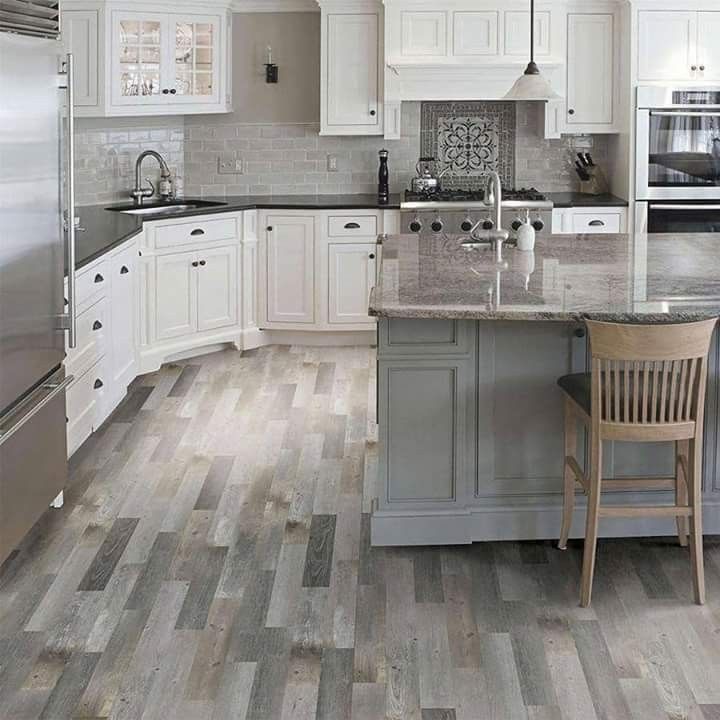 Kitchen tiles can be inexpensive only if they are vinyl, linoleum, but ceramics, especially custom-made ones, are always expensive. Specialty stores will help you evaluate everything that is required for your kitchen.
Kitchen tiles can be inexpensive only if they are vinyl, linoleum, but ceramics, especially custom-made ones, are always expensive. Specialty stores will help you evaluate everything that is required for your kitchen.
Striking design in black and brown
Consider the lifestyle of your household. Although kitchen tiles are durable, they still require attention, and the durability of each material is different.
Think through every detail when designing
Ceramic is strong enough to withstand heavy objects being dropped, easy to clean and maintain.
But, unfortunately, it is also often subjected to chips and cracks, especially with improper laying, as well as with improper operation. Determine if the flooring you choose will fit your family's lifestyle.
Multicolored floor tiles
When choosing a flooring, it must be strong enough to withstand heavy traffic, pets, spilled food and detergents.
Choose according to taste and design
Make sure you buy exactly what is called "floor tiles".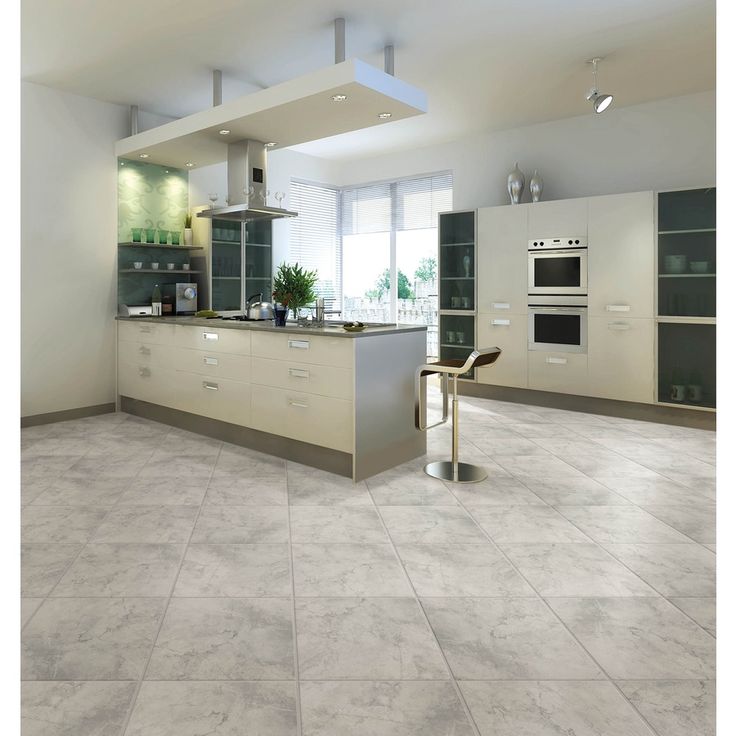 If you choose a low friction floor, the floor will be slippery to walk on.
If you choose a low friction floor, the floor will be slippery to walk on.
Choose with a slight embossed pattern or texture instead for a safer result.
Stone granite fits perfectly into the overall picture of the kitchen corner
For a more refined and elegant look, look at stone granite. It is based on clay and limestone that is fired to look like natural stone. Stone is more expensive than traditional ceramics, but looks great in the interior.
See also: Choosing tiles for a small bathroom. Optimal combination of style and design, TOP-10 solutions + 150 PHOTOHow to create the perfect floor
If you decide to make the floor yourself, my advice on laying it and a small master class will come in handy.
Spectacular dark tones look stunning
If you've made all the preparations like me, it's time to lay your new tile floor.
This guide will walk you through all the steps and I just want to help you complete your project as smoothly as possible and also ensure it looks great in your home for the long haul.
Before you start
It is important to prepare your existing floor, calculate the correct quantity, purchase and place key elements.
Extra large color range
This planning guide tells you everything you need to know. So, read how to plan.
Planning with taste
Tools and materials needed:
- floor tiles;
- for floor. Choose a high-strength, specialized ceramic-specific adhesive for your decking;
- primer. Choose between a powder solution to be mixed with water or pre-mixed and ready to use.
A beautiful interior with a touch of sophistication and comfort
Using a pre-mixed grout allows you to skip the hassle of do-it-yourself preparation, but a powdered grout can be useful if you want to avoid wastage.
Because you have to mix the exact amount needed for very small or very large rooms.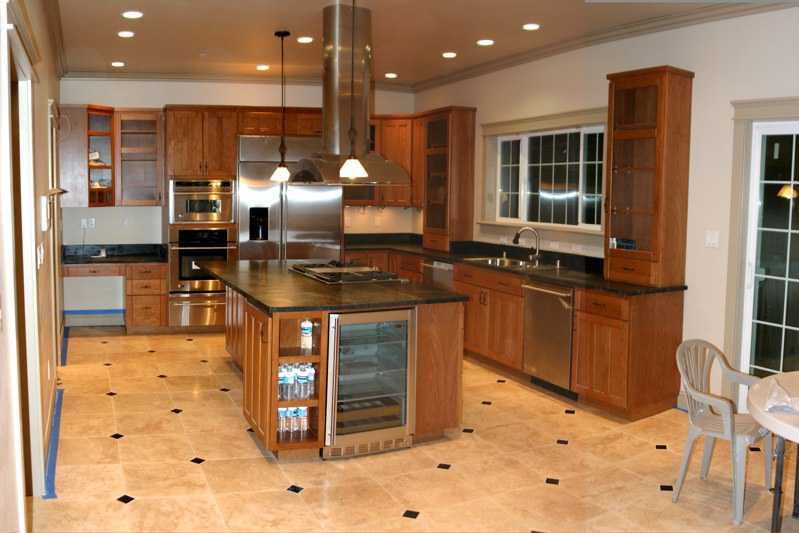
Use anti-mold solutions to keep your floors looking amazing
Look for anti-mold solutions for bathrooms and kitchens to help keep your floors in good condition for longer.
Installation tools:
- silicone sealant and cartridge;
- tools;
- notched trowel;
- tile spacers;
- tile file to remove redundant elements;
- electric cutter;
- molding machine;
- level;
- rubber mallet for fine leveling;
- sponge;
- soft cloth;
- respirator and goggles.
Installing ceramic and granite tiles is usually presented as a fairly simple procedure, followed by "just cut" advice with a wet saw.
In practice, it's not so easy to install everything with high quality
Then “lubricate the inside” and “set it in place” and finally “press it into the solution”, and then: voila, the magic happens. Perhaps this is really some kind of magic and should not be complicated? Not certainly in that way.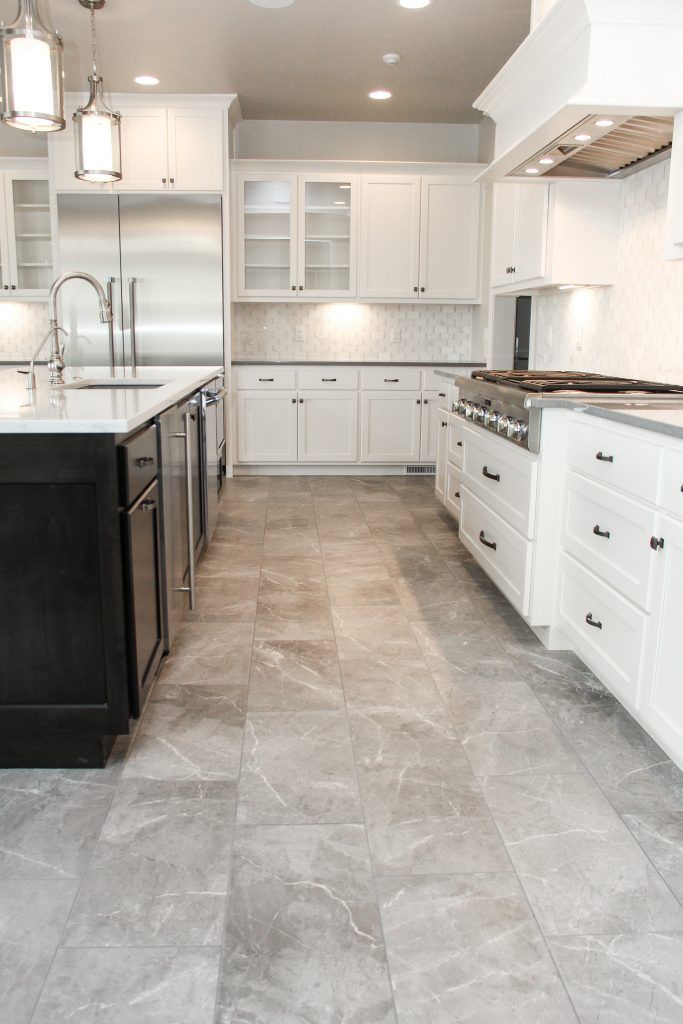
Do it yourself
If you are trying to save money, one way to approach this is to hire a professional for the most visible areas and the central part, leaving himself the legal right to do everything on his own in the corners that will be filled with furniture.
The material is easy to cut with the special tool
If you are not sure that you can lay everything straight, then it is worth hiring a professional installer to avoid irreparable mistakes.
A level floor will keep your kitchen surface durable
And for all the desperate home reformers like me, I suggest continuing with this guide.
One of the problems that will come your way is that it will be difficult to peel off if you make a mistake.
Beautiful combination of flooring with backsplash
Tile mortar allows for some movement, but unfortunately it will also shift the rest of the work, although this mostly applies to vertical masonry.
For this purpose, there is a tile that will be easier to remove and move if necessary.
Kitchen floor options
The following guide aims to show you the tricky parts of the job and how to do it in a way that's easier to remove.
See also: Design options for rooms in an apartment (+150 Photos). TOP 12 trends and TOP 4 anti-trendsEasy work
Projects and topics that are generally easier to complete are as follows:
Dry places
special work with the substrate material and sealing.
Updating the Interior Nicely and Quickly
Rain can be especially problematic for amateur tiles to make a problem area completely watertight.
Floors near walls
Slippage is something you will constantly struggle with when dealing with walls.
Small is also easy to install
Tiles ranging from 10 to 30 cm
Small size, especially if it is a mosaic, especially easy to install. Use self-adhesive (although it has very limited use).
Attention
Start your amateur career with tiles that will maximize your skills.
Hard work
Dry mortar for ceramics is quite cheap, but the problem is that it is difficult to mix.
The solution is to buy a pre-mixed solution. Although it is more expensive, it saves you from the process of correctly measuring the amount of water with powder.
A level floor surface is essential
In addition, mixing the dry matter is physically difficult. If you don't have a good floor, your tiles won't lay flat. In this case, damage will inevitably occur at adjacent edges that do not have the same height.
Bright colors are always pleasing and easy to perceive
Worse, a base floor that is not hard enough will eventually lead to cracking. Tiles that will be located around the perimeter must be cut.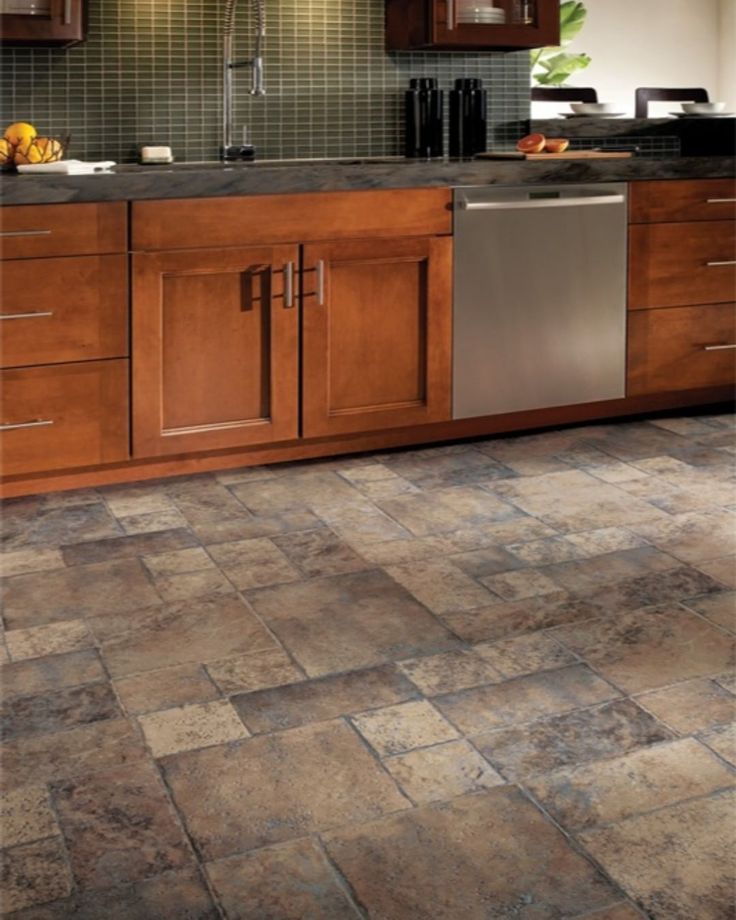 I used a wet grinder, or you can use a regular tile cutter.
I used a wet grinder, or you can use a regular tile cutter.
You will most likely want to use both types of cutting tools. If you have any chips, you can arrange them so that the problem area is under the baseboard or in another inconspicuous place.
Perfect combination with wood
Even perimeter tiles can be difficult. They don't automatically fall into straight lines: you'll have to work hard to get everything straight. Cutting, laying diagonally is very difficult and can be a real challenge for a beginner.
Proper alternation is difficult. Be sure to use plastic spacers for the correct spacing.
Make sure to use plastic spacers 9 for correct tiling.0003
While the spacers are very difficult to remove, they provide the perfect spacing. Constantly kneeling on a hard surface can affect the quality of your work. For this reason, when working yourself, it is worth buying an inexpensive pair of knee pads.
One way or another, self-laying is a complex and time-consuming process, so the first experience should be under the supervision of professionals.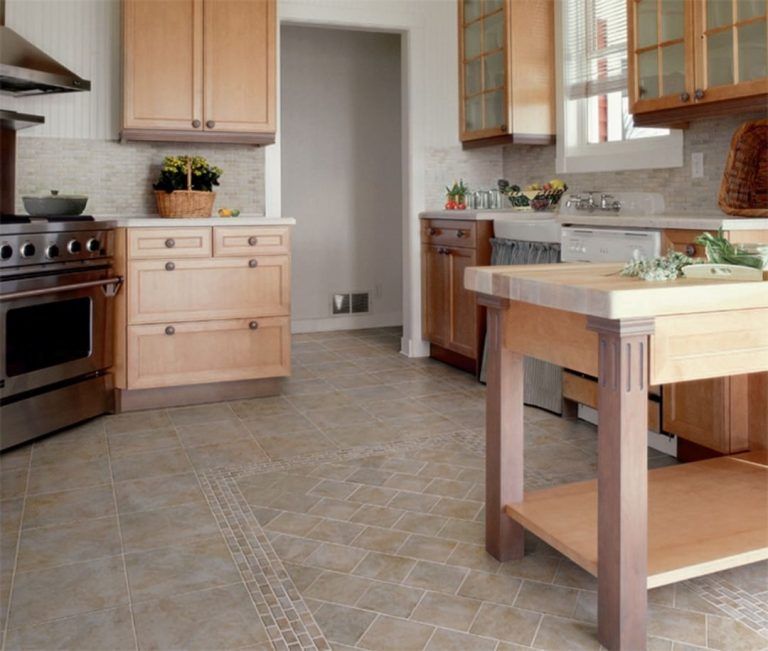
TOP-6 of the lead trends of kitchen tiles in 2019
1 Immitation of marble
Marble drawing
2 Imithing Parquet
Parquet of tiles
3 factor of fabric
Tiles repeats the fabric 9000,40002 4000
5Large tile
Large tile
6Hexagon
Hexagon tile
VIDEO: Floor tiles
Floor tiles
Use only the best ideas with us
Read also: Interior Fresco - How does it look in the hallway, living room, kitchen and bedroom? 150+ Photo Options for Original IdeasGALLERY: Best Kitchen Floor Tile Designs
9 Total Score
Are floor tiles really better?
Kitchen floor tiles are the most suitable option today. The availability of materials allows you to choose it to match the design. And you can get acquainted with its characteristics and types in our article. We have tried to collect complete information with beautiful photos. After reviewing the information, please leave your assessments with arguments in the comments. They will be helpful to other readers. Your opinion is very important to us. Thank you for your participation. We appreciate your feedback and your time.
The availability of materials allows you to choose it to match the design. And you can get acquainted with its characteristics and types in our article. We have tried to collect complete information with beautiful photos. After reviewing the information, please leave your assessments with arguments in the comments. They will be helpful to other readers. Your opinion is very important to us. Thank you for your participation. We appreciate your feedback and your time.
9EXPERT SCORE
The relevance of information
9,0002
Availability of application
8.5
Disclosure of the topic
8.5
Accuracy of information10
9000 9000 9000 9000 9000 9000 9000 9000 9000 9000 9000 9000 9000 9000 9000 9000 9000 9000 9000 9000 9000 9000 9000 9000 9000 9000 9000 9000 9000 9000 9000 9000 9000 9000 9000 9000 9000 9000 9000 9
Disclosure
9.7
Reliability of information
9.7
PROS
- Wear resistance
- Strength
- is not afraid of water
- A large selection of colors and texture
- Holds sliding movements
Cons
- Cold surface
- The laboriousness of styling
Add Your Reviewwear | Read reviews and comments
What is the best floor for the kitchen? Tips from PlazaReal in St.
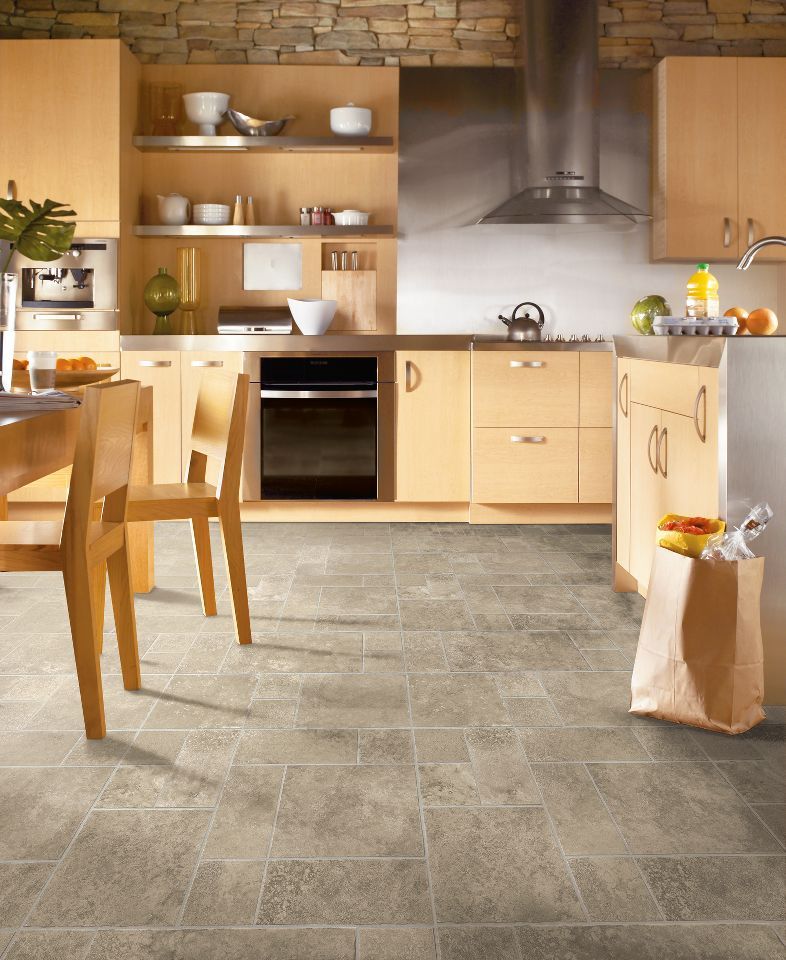 Petersburg
Petersburg During the overhaul of an apartment, the question inevitably arises of what is better to make the floor in the kitchen, what materials are preferable, what can and should not be used for this purpose. We give an overview of the most popular flooring and demonstrate how they look in the interior.
Which floor for the kitchen to choose so that it is waterproof, durable, beautiful and serves for many years? Focusing on the above description, the pros and cons of each material, it will be easy to understand which coating will be the best finishing option in your case:
- Ceramic tiles based on natural clays of various grades, pressed and fired at high temperature. The most important features are durability and environmental friendliness.
- Vinyl tile is a new generation multilayer material. Produced by hot pressing. Combines the best qualities of laminate and PVC linoleum.
- Porcelain stoneware - made from kaolinite clays, quartz sand, feldspars and coloring pigments.
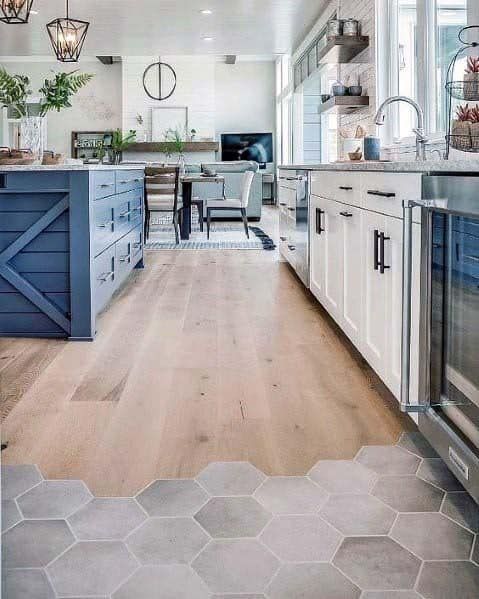 It is fired, acquiring the strength of a monolith.
It is fired, acquiring the strength of a monolith. - Marble is a natural rock formed from limestone subjected to high pressure. The color and pattern depends on the impurities of the minerals copper, chromium, manganese.
- Laminate - 4-ply board coated with resin-impregnated paper or cardboard. The pattern applied to the surface is covered with a protective film.
- Cork - cork oak bark, light, practically not abraded, not subject to decay.
- Linoleum - an artificial material on a foamed or monolithic basis of PVC (hard varieties) or on a polyester basis (soft). For the kitchen floor, the first ones are more practical.
Ceramic tiles
Clay tiles have been used for flooring since ancient Roman times. Until today, it ranks first among all types of floor coverings. True, it is not so easy to figure out what is better to put on the floor in the kitchen, because manufacturers offer an incredibly large number of variations of durable and beautiful floor ceramics.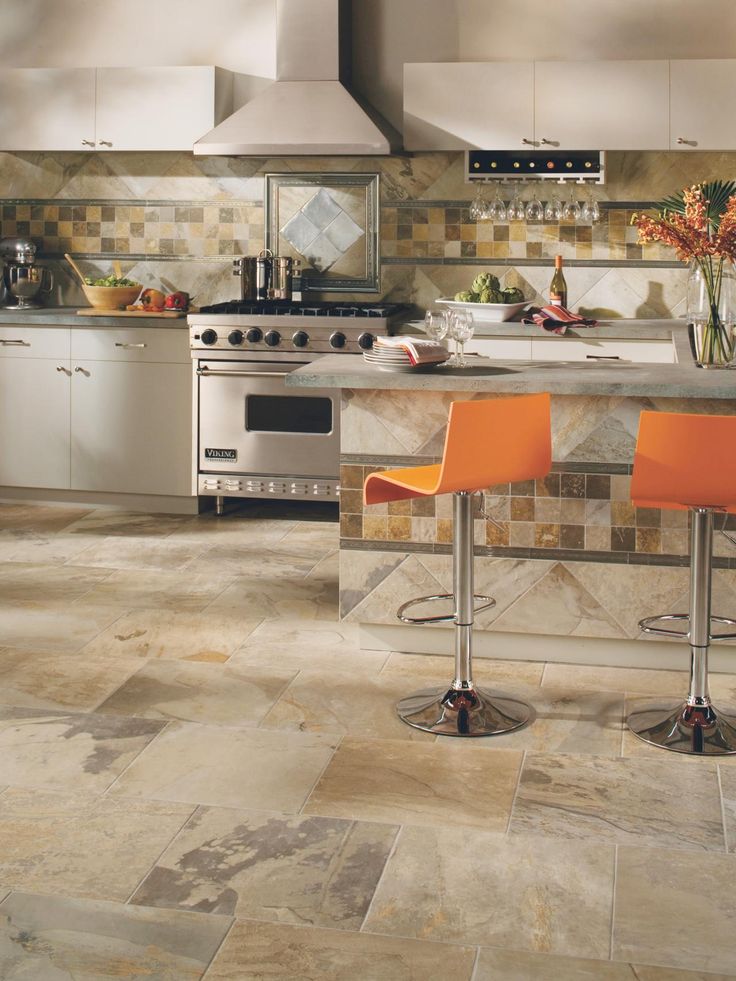
Ceramic tiles for the kitchen on the floor are easily combined with any design style. You can choose an option for both classic and loft or high-tech. Interesting color panels are laid out from it. It is easy to choose an option that imitates natural granite, marble, expensive wood.
When choosing ceramics, you need to remember that wall tiles for the kitchen are not suitable for the floor, they are used only for wall cladding. As a floor covering, tiles with a hardness of at least 4–5 and a wear resistance index of at least 4 points are used. Then it will serve as long as the life of the building itself is calculated.
The floor is tiled with a trendy geometric pattern.
When figuring out which tile to choose for the floor in the kitchen, you need to remember one important point. This is a place where you can spill anything on the floor: water, juice, vegetable oil (remember Bulgakov's Annushka!). The smooth surface thus turns into a skating rink.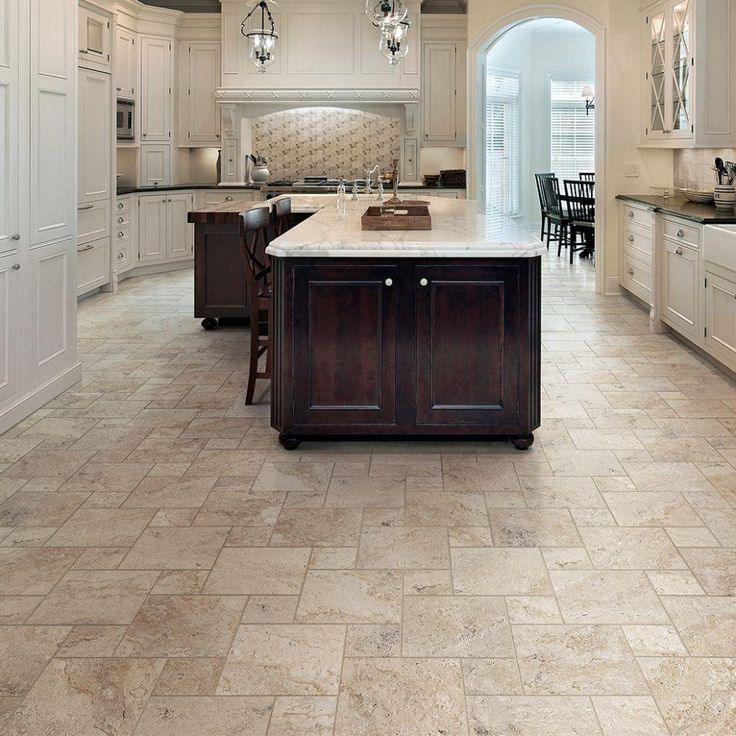 If you are concerned about "safety", it is better to pay attention to matte, non-slip tiles.
If you are concerned about "safety", it is better to pay attention to matte, non-slip tiles.
In fairness, we note or clinker. And one more thing: due to the special hardness, when a glass or crystal wine glass falls on the floor, there are no chances of survival (unlike laminate and linoleum).
Porcelain stoneware
This modern material appeared only about 30 years ago and firmly "settled" as a floor covering in public buildings and offices. Manufacturers produce various versions of porcelain stoneware, many of which are suitable for laying the floor in the kitchen in private houses and even high-rise apartments.
If, for example, the question is which floor to choose for a country cottage, porcelain stoneware tiles will be in place. It has a fantastic density: in ordinary ceramics, the degree of water absorption is about 10%, and in porcelain stoneware slabs it is less than 0.5%. She is not afraid of frost, has no limitations, a couple of disadvantages of a ceramic floor.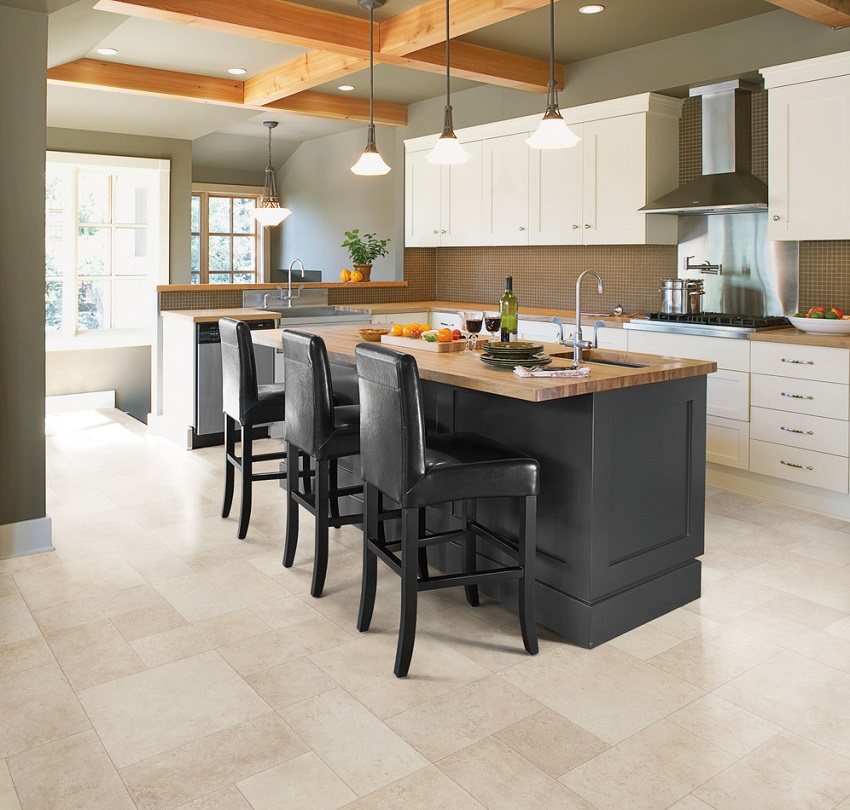 It is quite cold, so usually a heating system is provided for it. In this case, you can not use tiles made of red clay: only white is suitable.
It is quite cold, so usually a heating system is provided for it. In this case, you can not use tiles made of red clay: only white is suitable.
Laminate
Wood is not the best choice for covering the floor in the kitchen, as it reacts to moisture and temperature changes. For those who cannot refuse it, or the design suggests a wooden floor, a laminate will be a good alternative. The material is a two-layer plate covered with a moisture-resistant film and decorated with natural wood on the outside.
Positive qualities: the laminate is difficult to scratch, it retains its shape and original appearance well. Withstands temperatures up to 28⁰C, under such a coating you can safely equip a warm floor. The variety of imitations is huge: from dark oak to light birch, smooth slabs and with a pattern of natural wood. Service life, depending on the class, 15–50 years.
When choosing what is best to lay on the floor in the kitchen, you need to take into account the shortcomings of the material.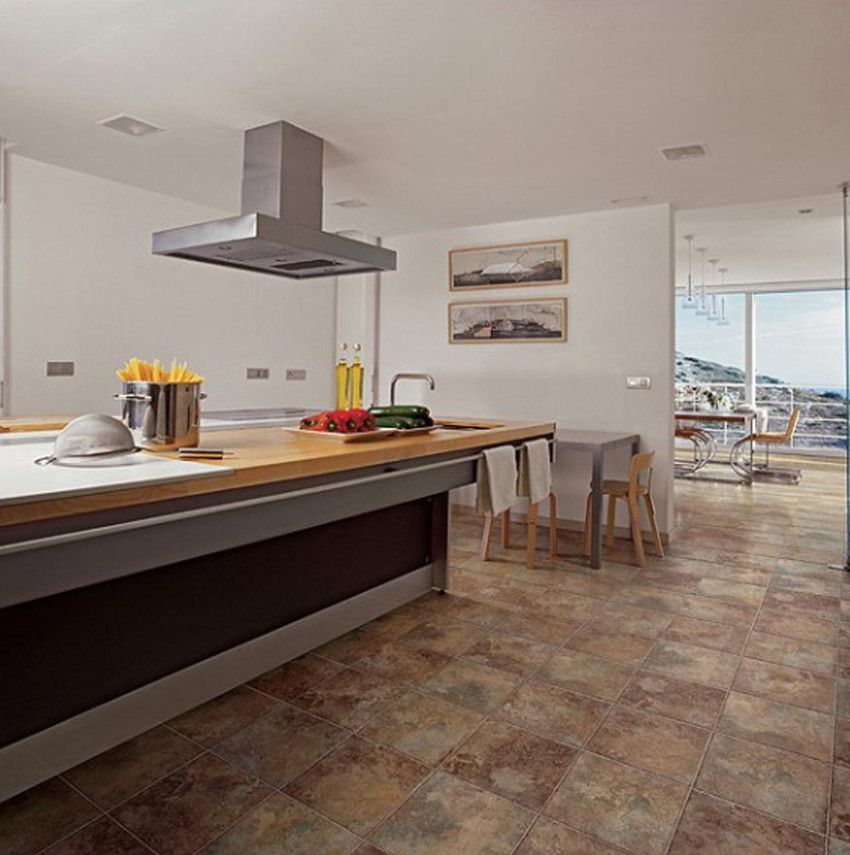 So, the laminate can not be filled with water when washing. If moisture seeps through the edges, the lamellas will begin to swell. Pay attention to special varieties for the kitchen: a special moisture-resistant wax impregnation is applied to such boards on all sides, including the ends.
So, the laminate can not be filled with water when washing. If moisture seeps through the edges, the lamellas will begin to swell. Pay attention to special varieties for the kitchen: a special moisture-resistant wax impregnation is applied to such boards on all sides, including the ends.
Laminate flooring needs to be laid on a soft substrate, but even this does not save neighbors from noise if you do not like to walk around the house in soft slippers. Do not drop pans and knives on the floor - for all the strength of the material, chips and cracks cannot be avoided in this case.
Valuable quality of a laminate with locks: a damaged board can be easily exchanged for a new lamella, so you need to leave some margin when laying.
Linoleum
When discussing which floor is better to make in the kitchen, we will definitely remember the well-deserved and once very popular linoleum. You should not compare modern varieties of this material with those that were produced twenty years ago.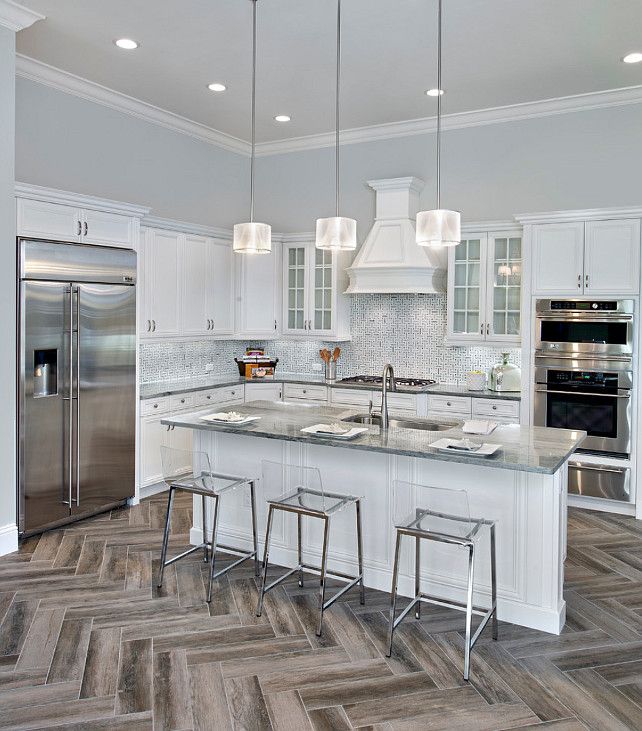 It has a lot of advantages: economical, wear-resistant, has a wide range of colors, is not afraid of moisture.
It has a lot of advantages: economical, wear-resistant, has a wide range of colors, is not afraid of moisture.
If you decide that laying linoleum on the floor in the kitchen will be the best option, you need to keep in mind a few rules:
- The subfloor must be level and dry. The thinner the linoleum, the stricter the requirements.
- Small bulges and irregularities will be evident, in addition, in such places the linoleum is quickly worn out.
- Single-color or stone-patterned coating is laid longitudinally from the window - this way the coating will appear more uniform.
- When cutting the material, there is always a margin for "cutting" to the walls. Usually it is 5-7 cm.
- After gluing, the linoleum must be “rolled” with a heavy roller or a special board.
Today, linoleum is produced not only in rolls, but also cut into tiles. This expands the design possibilities, facilitates the installation of coatings and reduces the number of scraps.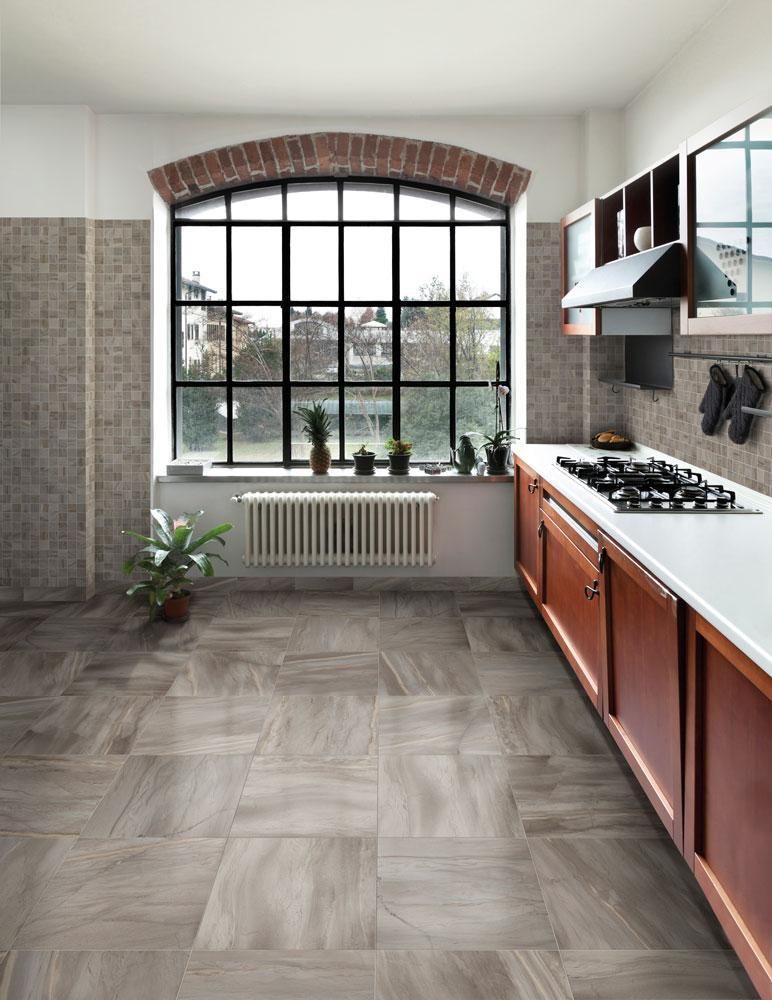 The appearance of linoleum is the most diverse. It successfully imitates natural stone, wood, and even metal. Stylish modern prints allow you to choose the flooring option for the kitchen in any style.
The appearance of linoleum is the most diverse. It successfully imitates natural stone, wood, and even metal. Stylish modern prints allow you to choose the flooring option for the kitchen in any style.
Cork floor
The original cork floor in the kitchen is not a cheap pleasure. However, it is a very durable and environmentally friendly material. Cork is obtained from the bark of a special type of oak that grows in the Mediterranean countries. It is warm, it is pleasant to walk on it barefoot, perfectly dampens sounds, does not absorb moisture, and is resistant to household chemicals. She is not liked by bugs and other rodents, she is not affected by mold. In addition, such floors have antistatic properties, which means that dust does not accumulate on them.
Cork is a rare and valuable material, so it is used economically. Two types of floor coverings are made from it. The first is chipboard panels covered with a thin bark veneer (0.5–1 mm). The second variety is more expensive: it is 100% natural material. The bark, crushed into crumbs, is pressed to obtain slabs, which are then decorated with veneer. Such a cork is called granular.
The bark, crushed into crumbs, is pressed to obtain slabs, which are then decorated with veneer. Such a cork is called granular.
If you have finally found something to lay the floor in the kitchen and cork floor is your choice, please note that the plates must be varnished, or it will need to be applied after laying.
Remarkable quality of a stopper — elasticity. The cork floor is not only pleasant to walk on: it also has a beneficial effect on the musculoskeletal system, reducing the load on the spine.
Vinyl floor
A new interesting material for lovers of experiments - PVC vinyl tiles for the kitchen on the floor. This is a cross between tile, linoleum and laminate. It is quite flexible, easy to install, at the same time comparable in strength to stone, and its decorative possibilities are simply endless. In appearance, the floor can look like granite, marble, there are textures that accurately imitate wood or even leather.
Advantages of vinyl flooring for the kitchen:
- service life up to 35 years, does not fade, does not scratch;
- easy installation, does not require a perfect base;
- is harmless to health, does not emit harmful fumes;
- is not afraid of water, household chemicals, does not slip;
- is a durable material that does not crack on impact.

Of the disadvantages of vinyl tiles, only its relatively high cost can be noted. But given the indisputable advantages, it fully justifies itself from all points of view. This is a great alternative to traditional ceramic tiles.
Screed
Under the self-leveling floor in the kitchen, two different operations are meant. More often they mean putting the base in order before laying laminate, carpet or linoleum. This is actually getting a thin, perfectly even screed using a dry water-soluble mixture. If it is brought to a liquid (spreading) state, it is often called self-levelling. Most "levelers" have a porridge-like consistency, which is distributed with a special tool.
The second option for self-leveling floors is the use of mixtures based on polyurethane or epoxy resins, on which, after pouring, you can not lay another coating. The composition can be transparent or colored, various decorative elements are added to it: figurines, shells, stones.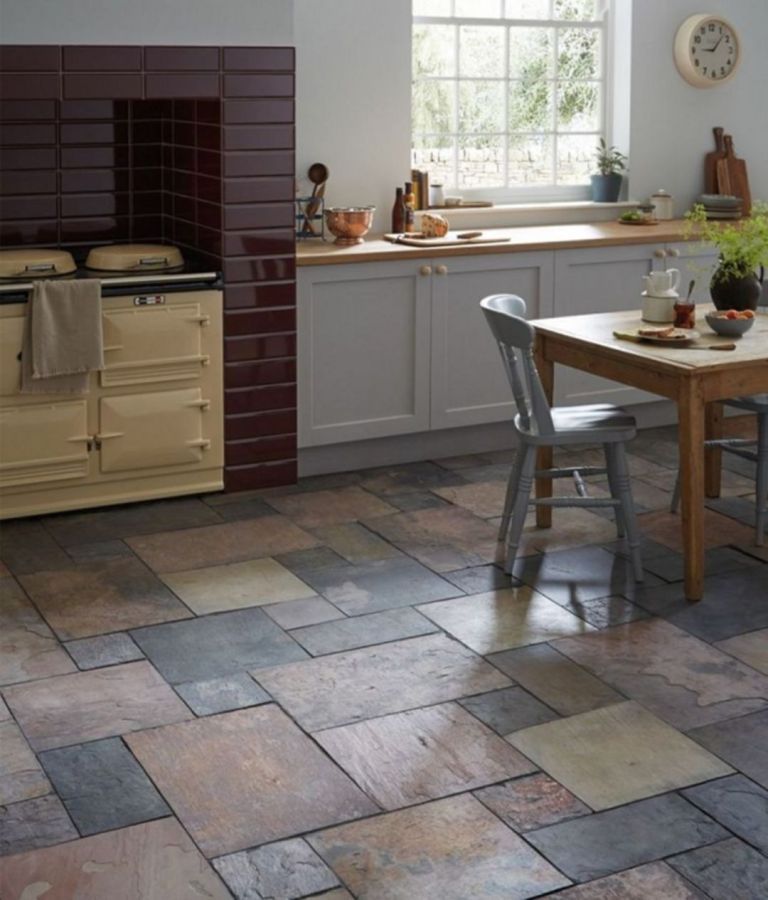 As a result, they get a kind of 3D self-leveling floors, and the kitchen turns into a real work of design art.
As a result, they get a kind of 3D self-leveling floors, and the kitchen turns into a real work of design art.
Marble
Natural marble floor in the kitchen is beauty, elegance, style. But there will be a lot of trouble with him. Both during installation and in subsequent operation. The greatest advantage of marble tiles is that they instantly transform the look of the room, giving it a luxurious, regal look.
Marble has many natural shades, the unique pattern of the stone is not repeated. It is easily cut, polished, acquiring a soft satin sheen. From it you can make any decorative pattern, up to a stone mosaic. It is absolutely safe, environmentally friendly material. However, like any other, it has a number of disadvantages that make it difficult to use in the kitchen:
- Brittle - Dropping heavy objects, especially metal, can cause chips, scratches, and cracks. Eliminating them is difficult.
- Reaction to acids - marble has a calcareous composition, so acidic sauces, wines, juices destroy it and leave indelible stains.
